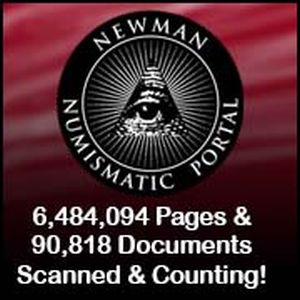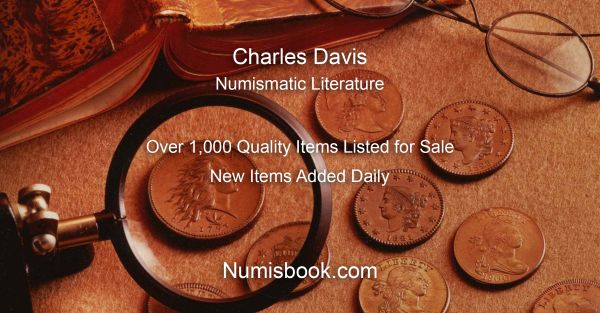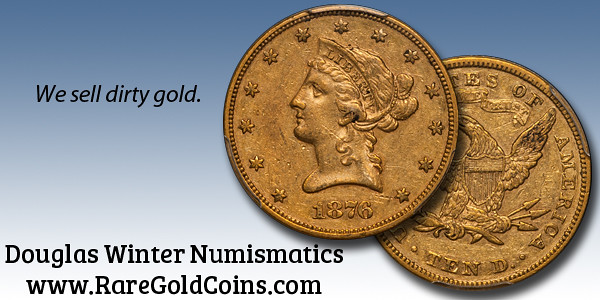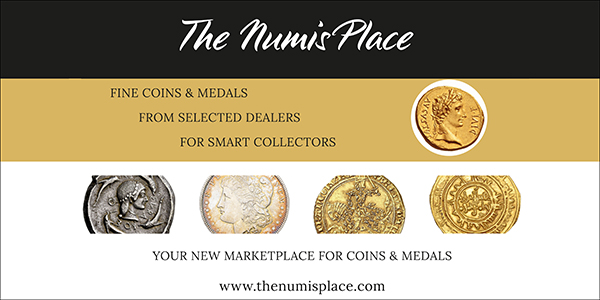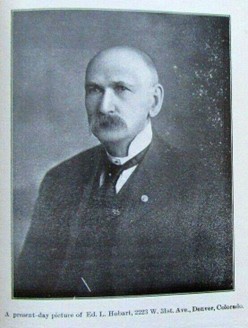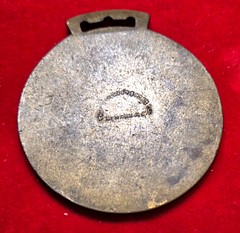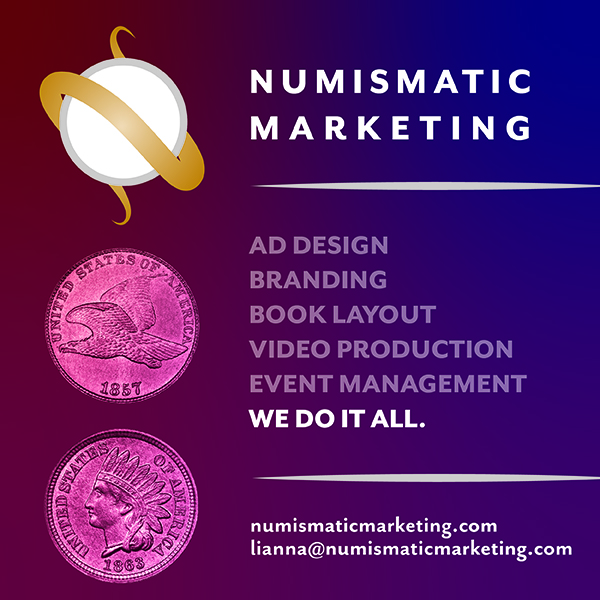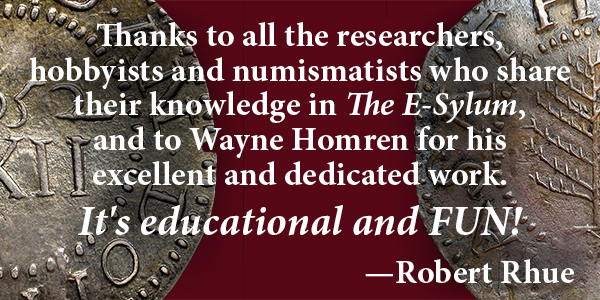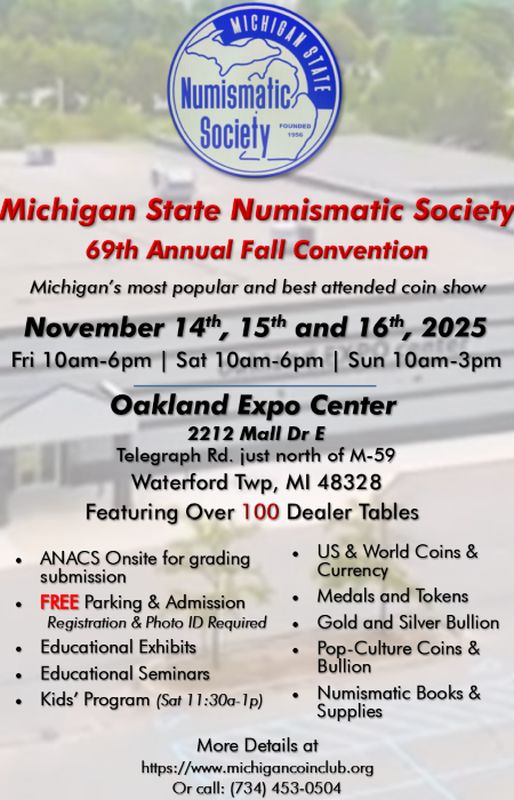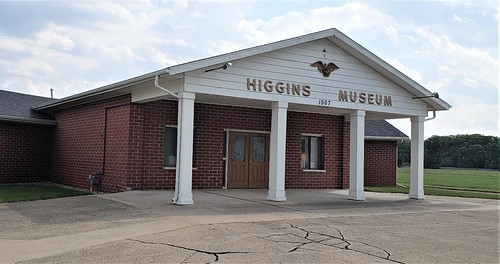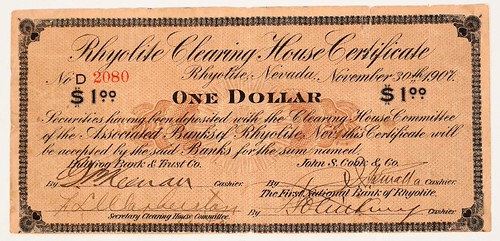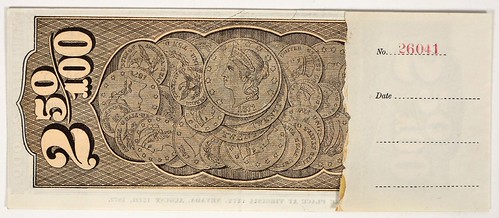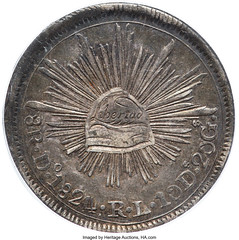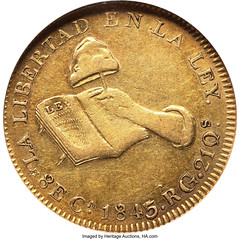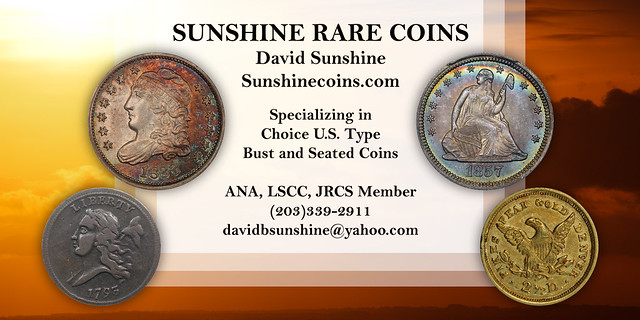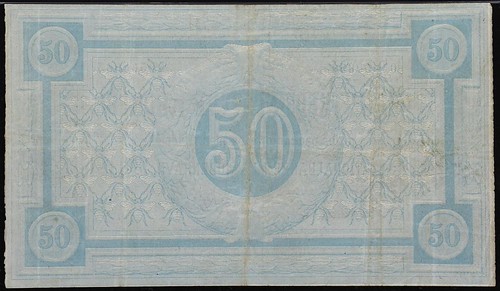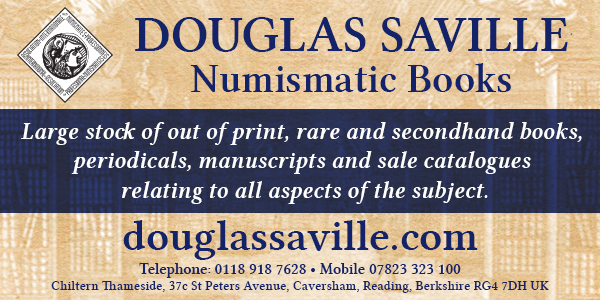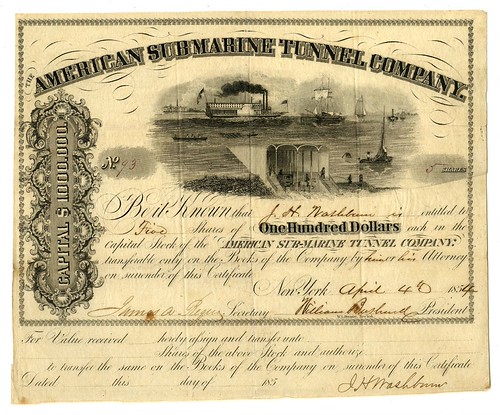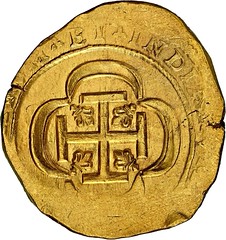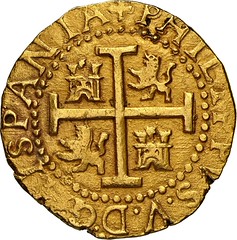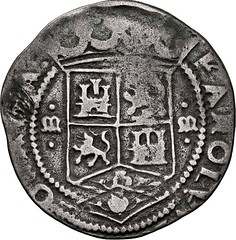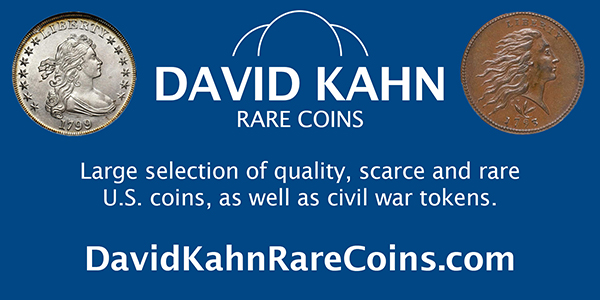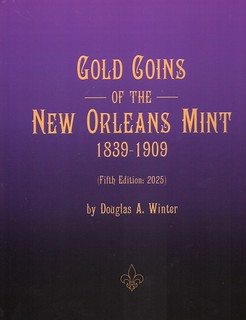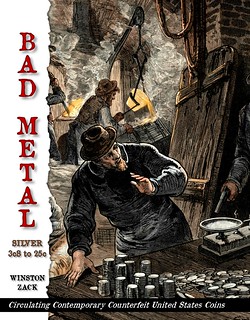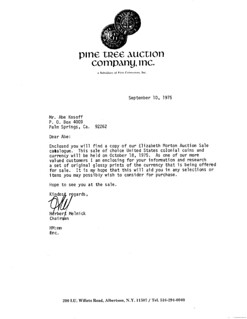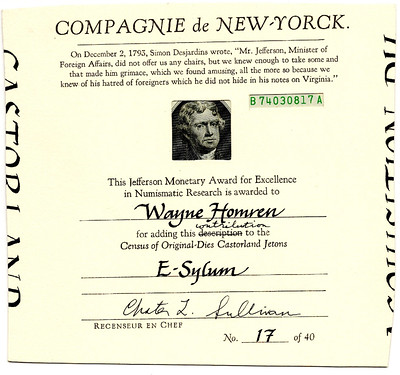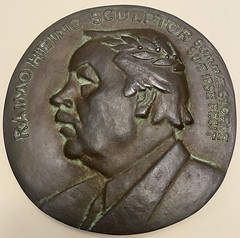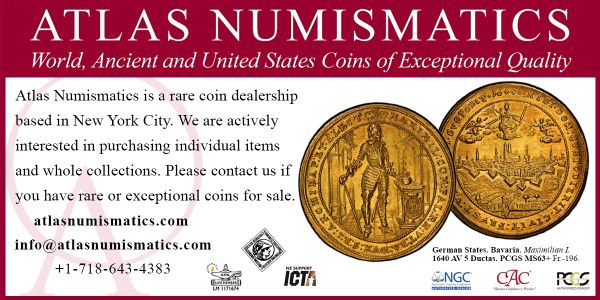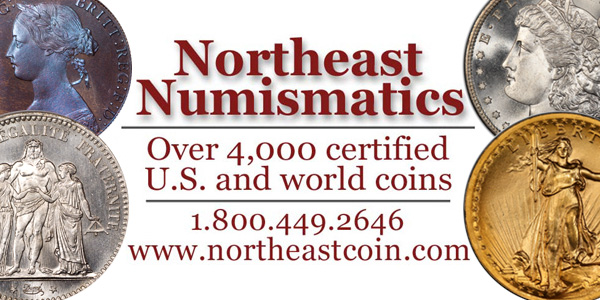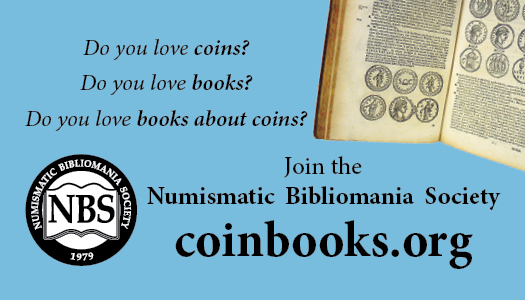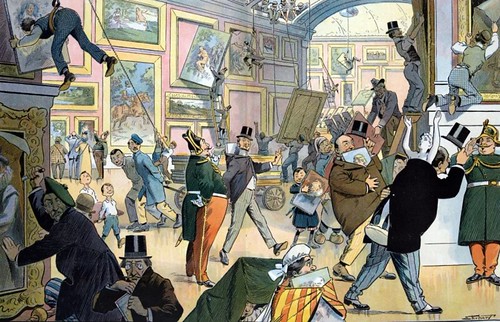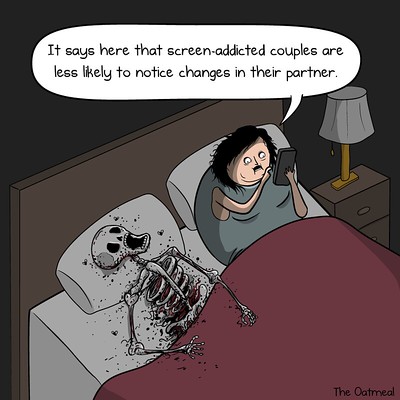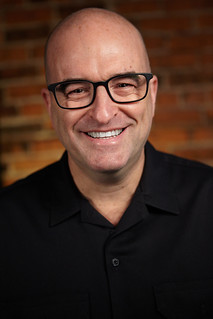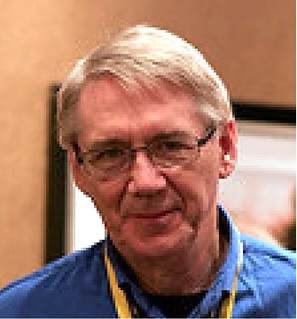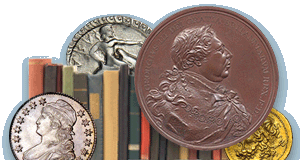
Visit our NBS Sponsors
About UsThe Numismatic Bibliomania Society is a non-profit association devoted to the study and enjoyment of numismatic literature. For more information please see our web site at coinbooks.org SubscriptionsThose wishing to become new E-Sylum subscribers can go to the following web page
Subscribe
MembershipThere is a membership application available on the web site Membership Application To join, print the application and return it with your check to the address printed on the application. Print/Digital membership is $40 to addresses in the U.S., and $60 elsewhere. A digital-only membership is available for $25. For those without web access, write to: Jeff Dickerson, Treasurer AsylumFor Asylum mailing address changes and other membership questions, contact Jeff at this email address: treasurer@coinbooks.org SubmissionsTo submit items for publication in The E-Sylum, write to the Editor at this address: whomren@gmail.com BUY THE BOOK BEFORE THE COINSale Calendar |
- WAYNE'S WORDS: THE E-SYLUM OCTOBER 26, 2025
- CNG ANS LIBRARY DUPLICATE CATALOG SALE
- JULIAN LEIDMAN NUMISMATIC LIBRARY SALE
- NEW BOOK: MODERN NUMISMATIC MASTERPIECES
- BUY THE PLASTIC, NOT THE COIN
- VIDEO: 2009 MONEY SHOW OF THE SOUTHWEST
- MORE ON DENVER MINT GUIDE PUBLISHER E.L. HOBART
- MORE ON THE BARON VON STEUBEN MEDALS
- NOTES FROM E-SYLUM READERS: OCTOBER 26, 2025
- 2025 FIDEM CONFERENCE REPORTS
- VOCABULARY TERM: RUSTED DIES
- VISITING THE HIGGINS MUSEUM
- MARQUIS WHO'S WHO ADDS DON EVERHART
- HOLDBIRD GRAND FINALE SALE SELECTIONS
- HERITAGE: MEXICO WORLD COINS SHOWCASE
- BRUUN SCANDINAVIAN PAPER MONEY RARITIES
- ARCHIVES INTERNATIONAL SALE 107 SELECTIONS
- SEDWICK AUCTION 38 SELECTIONS
- DAVISSON'S E-AUCTION 52
- BRADBURY WILKINSON BANK NOTE DESIGNS AND ESSAYS
- WAYNE'S NUMISMATIC DIARY: OCTOBER 26, 2025
- SPANISH COIN DISCOVERED ON NANTUCKET
- THE NORMAN WAIT HARRIS PRIZE MEDAL
- HAMILTON AND CHERNOW WIN LIBERTY MEDAL
- THE SMITH AND WINCHESTER MACHINE SHOP
- FRENCH MUSEUM THEFTS
- MRBEAST CASH STUNTS
- LOOSE CHANGE: OCTOBER 26, 2025
- ABOUT THIS ISSUE: OCTOBER 26, 2025
Content presented in The E-Sylum is not necessarily researched or independently fact-checked, and views expressed do not necessarily represent those of the Numismatic Bibliomania Society.
WAYNE'S WORDS: THE E-SYLUM OCTOBER 26, 2025
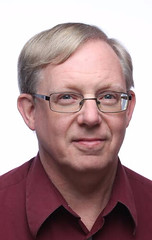 New subscribers this week include:
Royal Mint Museum Director Dr Kevin Clancy, and
John Koar, courtesy Dave Hayes.
Welcome aboard! We now have 6,782 subscribers.
New subscribers this week include:
Royal Mint Museum Director Dr Kevin Clancy, and
John Koar, courtesy Dave Hayes.
Welcome aboard! We now have 6,782 subscribers.
Thank you for reading The E-Sylum. If you enjoy it, please send me the email addresses of friends you think may enjoy it as well and I'll send them a subscription. Contact me at whomren@gmail.com anytime regarding your subscription, or questions, comments or suggestions about our content.
This week we open with two numismatic literature sales, one new book, updates from the Newman Numismatic Portal, and more.
Other topics this week include collectible early slabs, the FIDEM conference, the Higgins Museum, rusted dies, a tsunami of auction selections, Mexican coins, Scandinavian banknotes, the Norman Wait Harris prize medal, museum thefts, and MrBeast's cash stunts.
To learn more about modern numismatic rarities, Edwin L. Hobart, Baron Von Steuben medals, Fancy Turning, Jim Licaretz, Don Everhart, Revolutionary War Loan Certificates, banknote designer Richard Adams, the Liberty Medal, and the metal-detecting Man from Nantucket, read on. Have a great week, everyone!
Wayne Homren
Editor, The E-Sylum
CNG ANS LIBRARY DUPLICATE CATALOG SALE
In their October 23, 2025 "This Week at the ANS" email, the American Numismatic Society announced an auction by Classical Numismatic Group of duplicate catalogs from the ANS Library. -Editor
CNG Auction of Numismatic Literature from the ANS Library
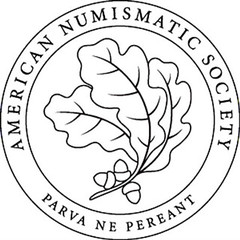 An online auction now underway at CNG presents a great opportunity to expand your own numismatic auction library while supporting the Harry W. Bass, Jr. Library at the American Numismatic Society. Lots 1202–1393 of CNG's Electronic Auction 598 feature duplicate catalogs from the ANS Library, dating from 1900 through 1977. Among them are selections from Leonard Forrer (Stroehlin Collection, 1911), Adolph Hess, Brüder Egger, Jacques Schulman, Émile Bourgey, Bank Leu, Michele Baranowsky, Rodolfo Ratto, Adolph E. Cahn, Ludwig Grabow, P. & P. Santamaria, and many others.
An online auction now underway at CNG presents a great opportunity to expand your own numismatic auction library while supporting the Harry W. Bass, Jr. Library at the American Numismatic Society. Lots 1202–1393 of CNG's Electronic Auction 598 feature duplicate catalogs from the ANS Library, dating from 1900 through 1977. Among them are selections from Leonard Forrer (Stroehlin Collection, 1911), Adolph Hess, Brüder Egger, Jacques Schulman, Émile Bourgey, Bank Leu, Michele Baranowsky, Rodolfo Ratto, Adolph E. Cahn, Ludwig Grabow, P. & P. Santamaria, and many others.
Every purchase benefits the ANS Library, so make your bids today! The auction will close on October 29, 2025.
For more information, or to bid, see:
Duplicates from the Library of the American Numismatic Society
(https://auctions.cngcoins.com/lots?categories=4-IGVGYQ)
JULIAN LEIDMAN NUMISMATIC LIBRARY SALE
Dealer Stephanie Hudson of Carolina Silver & Gold in Greensboro, NC will be selling Julian Leidman's numismatic library. She posted an announcement on Facebook Friday. Here's an excerpt. -Editor
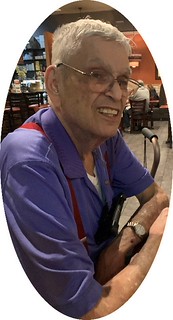 Starting this Monday, I'll begin sharing select pieces from Julian M. Leidman legendary numismatic book collection!
Starting this Monday, I'll begin sharing select pieces from Julian M. Leidman legendary numismatic book collection!
Initially, items will be available for fixed-price purchase + shipping on my personal Facebook page. After 24 hours, we'll cross-post them elsewhere for wider access.
Please allow 3–5 business days for shipping once payment is received.
Get ready — there are some incredible coin reference guides, Personally signed literature from the authors, historic auction catalogs, quite a few with personal annotations from Julian himself coming your way!
To read the complete Facebook post, see:
https://www.facebook.com/groups/1145253708909091/permalink/24325280070479794/
For Stephanie's Facebook page, see:
Stephanie Hudson
(https://www.facebook.com/groups/1145253708909091/user/1228209449/)
NEW BOOK: MODERN NUMISMATIC MASTERPIECES
Stephen Pfeil of Global Coin LLC in Madison, Wisconsin -Editor
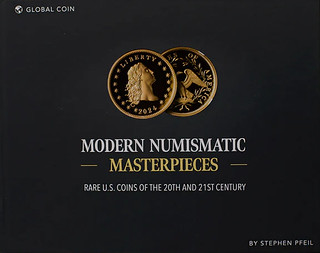 Global Coin is proud to announce the upcoming release of Modern Numismatic Masterpieces: Rare U.S. Coins of the 20th and 21st Century by Stephen Pfeil, an authoritative and visually striking exploration of America's most remarkable modern coins. Officially releasing October 21st, 2025, the book is available now for preorder at ShopGlobalCoin.com.
Global Coin is proud to announce the upcoming release of Modern Numismatic Masterpieces: Rare U.S. Coins of the 20th and 21st Century by Stephen Pfeil, an authoritative and visually striking exploration of America's most remarkable modern coins. Officially releasing October 21st, 2025, the book is available now for preorder at ShopGlobalCoin.com.
With forewords by Stephanie Sabin, President of the Professional Coin Grading Service (PCGS), and Anna Escobedo Cabral, the 42nd Treasurer of the United States, Modern Numismatic Masterpieces bridges artistry, history, and investment insight in a way few publications ever have.
"A visually stunning and thoughtfully curated collection that showcases the diversity and craftsmanship of modern coinage… a valuable resource for anyone interested in how contemporary coins continue to tell the stories of our time."
— Douglas Mudd, Curator, Edward C. Rochette Money Museum, American Numismatic Association
The book's thoughtful presentation and rich educational value have earned it a place in the American Numismatic Library, cementing its position as a defining reference for both collectors and researchers.
The first limited printing of 2,000 copies carries a special incentive:
- 100 copies contain Silver Tickets redeemable for a U.S. Silver Eagle
- 1 Golden Ticket will grant its finder a 2025 $50 Gold Eagle (MS70 condition)
"Education is the key to a vibrant collecting community," writes Thomas J. Uram, former President of the American Numismatic Association. "Stephen Pfeil's book empowers collectors to make better, more informed decisions—an outstanding contribution to numismatic education."
From design to distribution, Modern Numismatic Masterpieces embodies the values that define Global Coin: trust, education, and legacy. This book not only celebrates the evolution of American coinage but also reinforces the idea that every great collection begins with knowledge.
Here's more about the author from his blog. -Editor
 As the founder of Global Coin, I've dedicated over three decades to the world of numismatics, where each coin is a portal to history, artistry, and opportunity. My journey began with a single coin—a 1907 Saint-Gaudens Double Eagle—whose weight, intricate design, and historical significance ignited a lifelong passion. That moment transformed a casual interest into a mission to share the joy and value of coin collectibles with collectors and investors worldwide. At Global Coin, we specialize in modern rare coins, sourcing treasures like the 2025 American Buffalo Gold Proof Coin in PR70, signed by PCGS President Stephanie Sabin, with only 20 in existence.
As the founder of Global Coin, I've dedicated over three decades to the world of numismatics, where each coin is a portal to history, artistry, and opportunity. My journey began with a single coin—a 1907 Saint-Gaudens Double Eagle—whose weight, intricate design, and historical significance ignited a lifelong passion. That moment transformed a casual interest into a mission to share the joy and value of coin collectibles with collectors and investors worldwide. At Global Coin, we specialize in modern rare coins, sourcing treasures like the 2025 American Buffalo Gold Proof Coin in PR70, signed by PCGS President Stephanie Sabin, with only 20 in existence.
To read the complete articles, see:
"Modern Numismatic Masterpieces" Celebrates the Art and Legacy of America's Coinage
(https://www.barchart.com/story/news/35599052/modern-numismatic-masterpieces-celebrates-the-art-and-legacy-of-americas-coinage)
My Journey into Coin Collectibles: A Coin Collector Guide
(https://shopglobalcoin.com/blogs/blog/my-journey-into-coin-collectibles)
For more information, or to order, see:
Modern Numismatic Masterpieces: Rare U.S. Coins of the 20th and 21st Century
(https://shopglobalcoin.com/products/modern-numismatic-masterpieces-rare-u-s-coins-of-the-20th-and-21st-century)
BUY THE PLASTIC, NOT THE COIN
The newest addition to the Newman Numismatic Portal is the latest issue of David Schwager's Sample Slab Newsletter. Project Coordinator Len Augsburger provided the following report. -Editor
Buy the Plastic, Not the Coin
The advent of third party grading in the 1980s has revolutionized the field of U.S. coin collecting, and the slabs themselves have become collectible. What is collecting if not preserving significant artifacts of the past? In this sense, these plastic holders have legitimately captured collectors' attention (and wallets), with recent eye-popping results. The latest issue of David Schwager's Sample Slab Newsletter comments on the earliest PCGS holders.
 "In 2025…two PCGS type 1.0 holders from the first few days of PCGS shattered records. The first PCGS serial was about 1080001. Great Collections sold serial 1080094 (about the 94th coin certified by PCGS) holding an MS63 1904 double eagle on May 25, 2025 for a never-before-seen $45,374. An August 10 sale the same year, for serial 1080017 (about the 17th coin certified by PCGS) holding an MS63 1881-S Morgan yielded a staggering $119,062….As set registries have proven, collectors will pay many multiples of the price of typical material to get the very best. About 1,000 coins were put in type 1.0 holders and a census shows about 50 known to exist today. No PCGS 1.0 will sell for less than $10,000 again."
"In 2025…two PCGS type 1.0 holders from the first few days of PCGS shattered records. The first PCGS serial was about 1080001. Great Collections sold serial 1080094 (about the 94th coin certified by PCGS) holding an MS63 1904 double eagle on May 25, 2025 for a never-before-seen $45,374. An August 10 sale the same year, for serial 1080017 (about the 17th coin certified by PCGS) holding an MS63 1881-S Morgan yielded a staggering $119,062….As set registries have proven, collectors will pay many multiples of the price of typical material to get the very best. About 1,000 coins were put in type 1.0 holders and a census shows about 50 known to exist today. No PCGS 1.0 will sell for less than $10,000 again."
One can quibble with the valuations, but the market impact of these plastic containers is undeniable.
These early PCGS holders represent only a part of the slab collecting field, which includes hundreds of types from both current and long-forgotten certification services, in addition to special issues created to commemorate a wide variety of personalities, collections, and events. Collectors are served by Schwager's Sample Slab Newsletter in addition to a reference volume authored by Schwager and Burton Strauss.
Image: 1881-S Morgan, PCGS MS63, serial #1080017, sold by Great Collections August 10, 2025, realized $119,062.
Link to the Sample Slab Newsletter on NNP:
https://nnp.wustl.edu/library/publisherdetail/514437
Link to order David Schwager and Burton Strauss's reference work on sample slabs:
https://sampleslabs.info/ordering2025.html
THE BOOK BAZARRE
VIDEO: 2009 MONEY SHOW OF THE SOUTHWEST
The David Lisot Video Library on the Newman Numismatic Portal can be found at:
https://nnp.wustl.edu/library/multimediadetail/522852
We highlight one of his videos each week in The E-Sylum. Here's a different one from 2009 about the Money Show of the Southwest Coin Convention. -Editor
With Carl Schwenker, Robert Campbell, Larry Shepherd, James Bevill, Kids Corner and more.
Speaker(s): Edward Johnson, President.
To watch the complete video, see:
Money Show of the Southwest Coin Convention Highlights 12-3-09
(https://www.youtube.com/watch?v=Mj835UbP3ns)
Money Show of the Southwest Coin Convention Highlights 12-3-09
(https://nnp.wustl.edu/library/book/578928)
MORE ON DENVER MINT GUIDE PUBLISHER E.L. HOBART
Regarding Roger Burdette's question about Denver Mint guide publisher Edwin L. Hobart, Julia Casey writes:
"Unfortunately, I did not locate his mint publication; however, I found that he published other works, including a family genealogy and works about service in the Civil War. His publication about the Illinois Black Regiment (he was an officer) is noted as rare and sold for $750 in a Worthpoint listing.
"There are also references to applications he made in the 1890s seeking disability pension funds, as by that time, war service scurvy had caused him to lose all his teeth. He was also wounded and suffered from other diseases. Even with all this, he lived to 90 and died in 1935.
"There is a neat photo of him in his library (from his Hobart genealogy book)."
Here are some of Julia's notes and discoveries. Thank you! Roger Burdette is working on a future article on Hobart, and we passed everything along to him. -Editor
Links:
https://www.worthpoint.com/worthopedia/semi-history-boy-veteran-black-3895997963
https://archive.org/details/PublishersWeekly1910/1910-05-07/page/1884/mode/1up
https://www.seekingmyroots.com/members/files/G002917.pdf
https://archive.org/details/decisionsdepart05bixlgoog/page/319/mode/2up
https://www.findagrave.com/memorial/31021063/edwin-lucius-hobart
To read the complete article, see:
QUERY: HOBART'S DENVER MINT BOOKLET
(https://www.coinbooks.org/v28/esylum_v28n42a15.html)
MORE ON THE BARON VON STEUBEN MEDALS
Regarding Bob Fagaly's question on the Baron Von Steuben medals, Julia Casey writes:
"The 1976 medal should be signed A. Kolb on the obverse for Alphonse Kolb. Kolb has been mentioned in the E-Sylum before. The watch fob is said to date from about 1890 or so, and the maker's mark on the back should read Whitehead & Hoag."
Julia added these research notes. Thank you! -Editor
https://archive.org/details/thanksgivingweek1982john/page/68/
https://archive.org/details/thanksgivingsale1981john/page/18/
One of these sold recently on eBay. I couldn't read the maker mark on the back of the E-Sylum photo, but was able to use the auction listing that identified Whitehead & Hoag. This photo is a bit clearer to show it.
Worthpoint listing for another of the Kolb medals
https://www.worthpoint.com/worthopedia/friederich-steuben-inspector-generals-4885820482
A 2008 E-Sylum article is on Alphonse Kolb and an article from 2009 mentions Kolb possibly making medals for the Steuben Society.
To read the earlier E-Sylum articles, see:
MORE ON SCULPTOR ALPHONSE ANTON KOLB
(https://www.coinbooks.org/esylum_v11n45a08.html)
QUERY: WERE STEUBEN SOCIETY MEDALS DESIGNED BY ALPHONSE KOLB?
(https://www.coinbooks.org/esylum_v12n25a17.html)
NOTES FROM E-SYLUM READERS: OCTOBER 19, 2025 : Query: Baron Von Steuben Medals
(https://www.coinbooks.org/v28/esylum_v28n42a14.html)
NOTES FROM E-SYLUM READERS: OCTOBER 26, 2025
Book: Specimens of Fancy Turning
NYC dealer Peter Kraus of Ursus Books, Ltd. writes:
"My good friend Gil Parsons suggested that I let your readers know about a rare and extremely interesting American book I have, which Gil feels would be of interest to people who are interested in bank note engraving. the description is below."
[WOOLSEY, Edward J.] Specimens of fancy turning: executed on the hand or foot lathe: with geometric, oval, and eccentric chucks, and elliptical cutting frame. [2], 2 pp. and 30 unnumbered leaves of plates. 4to, 220 x 180 mm, publisher's green cloth. Philadelphia: Henry Carey Baird, 1869. $15,000.00
A fine copy of this wonderful example of the use of photography in America in the nineteenth century. In the preface Woolsey states that he made these images. Inspired by "an amateur friend", whose "exquisite productions" were too delicate to be successfully photographed, these "coarser" designs were produced by first applying India ink to an enameled card with a "flat camel's hair brush". The card was then fastened to the face of a chuck with tacks or mucilage, whereby a spring tool "cut through the blackened surface of the card, exposing to view the white paper". The cards were subsequently photographed. "They lack, however, the depth of black background, which cannot be equaled by the solutions of silver employed by the photographer." A fine copy of this rare book.
For more information, see:
Specimens of fancy turning: executed on the hand or foot lathe: with geometric, oval, and eccentric chucks, and elliptical cutting frame
(https://www.ursusbooks.com/pages/books/171762/edward-j-woolsey/specimens-of-fancy-turning-executed-on-the-hand-or-foot-lathe-with-geometric-oval-and-eccentric)
Thank you - very interesting - I was not familiar with this publication. I found more information at the link below. -Editor
This early photography book features thirty tipped-in albumen silver prints of geometric designs created on "the hand or foot lathe". Resembling something between spirograph drawings and textbook diagrams of orbiting electrons, the figures were created using geometric, oval, and eccentric chucks and an elliptical cutting frame. Attributed to "an amateur" on its title page, the book is the work of Edward J. Woolsey (1803–1872), an heir of the mercantile Woolsey family and partner in the New York Patent Sugar Refinery.
To read the complete article, see:
https://publicdomainreview.org/collection/fancy-turning/
(https://publicdomainreview.org/collection/fancy-turning/)
The Hamilton Fish Trade Dollar Set
Saul Teichman writes:
"The video regarding aluminum use in pattern coins etc, did have some errors in it. The most obvious being the Hamilton Fish trade dollar set was struck in silver not aluminum."
To read the earlier E-Sylum article, see:
NOTES FROM E-SYLUM READERS: OCTOBER 19, 2025 : Videos: Aluminum Patterns, 1804 Dollar Provenances
(https://www.coinbooks.org/v28/esylum_v28n42a14.html)
More on Zanzibar Banknotes
Gene Hessler writes:
"I have been intrigued by Zanzibar for decades and have kept a list of notes and serial numbers during this time. Serial number 20780 for a P3 10 rupee is not on my list. I believe this note might be one that has not been auctioned before, and might be of interest to some collectors for this reason.
"In 1964 a State Dept. 18-country concert tour of Africa took me to exotic Zanzibar, the highpoint of the trip, for me."Thank you. Great note. -Editor
To read the earlier E-Sylum article, see:
HERITAGE: OCTOBER 2025 WORLD PAPER MONEY
(https://www.coinbooks.org/v28/esylum_v28n41a22.html)
Query: Colonial Coin Club
Roger Moore writes:
"Wayne Shelby found a number of wooden nickels listed on eBay with the legend "Colonial Coin Club of Penna." and others with the related legend "Colonial Coin Club Levittown, PA." Two examples are shown below. Does anyone know anything about a 1970s Colonial Coin Club located in Levittown, Pennsylvania? "The Friendly Club" was evidently founded in 1962. If you have information, please respond to: rogermoore435@yahoo.com."
Interesting. Can anyone help? -Editor
2025 FIDEM CONFERENCE REPORTS
Mel Wacks submitted this announcement of the winner of the Gran Prix award at this year's FIDEM conference. Thanks. -Editor
The winner of the coveted Gran Prix award at the XXXVIII FIDEM MÜNICH 2025 (Fédération Internationale de la Médaille d'Art), was American medalist Jim Licaretz. Licaretz is only the second American to win since the Grand Prix was established in 1992.
According to the FIDEM website, The jury, comprised of Australian delegate and former Grand Prix winner Michael Meszaros, Portuguese delegate and Executive Committee member João Bernardo dos Santos, and congress organization member David Weidgenannt, made the following considerations regarding their decision: “Jim Licartez's work Autoritratto di Fantasia presented a strong design that directly addressed the subject. The title of the medal perfectly captures the key to its meaning. In this excellent self-portrait, the face looks into the distance while the brain focuses on fantasy and recalls the past. The ring forms a circle that contains the idea and creates a private space for the imagination. A range of fantasies, memories, and influences is suggested by the small panels springing from the head — antiquity, literature, music, mystery. The medal was beautifully modelled, cast, and patinated, representing a perfect marriage of innovation and traditional values.
The artist himself describes the medal in the exhibition catalogue as: "Thinking about medals I have made over the last few years." Licaretz goes on to describe the medals pictured above his exploded head as "Paul Auster, esteemed Jewish author and filmmaker, Leonard Bernstein, a great Jewish composer, and at the top right, a piece called Momento Mori – female nude with skulls. At the lower left is a medal of Akhenaten, a rather infamous Egyptian Pharoah."
The self-standing 4 x 4 x 1 inch bonded bronze Autoritratto di Fantasia medal can be ordered for $125 by contacting jimlicaretz@gmail.com or 310-686-0920.
George Cuhaj sent this conference report and additional images. The first image is the cover of the conference exhibition catalog. Thanks! -Editor
 The contemporary art medal exhibition and conference recently was held in Munich,
Germany. Under the title of "Our Myths, Our Roots" the public exhibition consisted of
just over 650 medals and is presented in a profusely illustrated catalog 260 page
catalog edited by Martin Hirsch and David Weidgenannt of the Staatliche Munzsannlung
Munchen (Munich Coin Cabinet). The medals are on display until January 2026 at the
Staatiche Antikensammlungen museum in the Koingplatz complex.
The contemporary art medal exhibition and conference recently was held in Munich,
Germany. Under the title of "Our Myths, Our Roots" the public exhibition consisted of
just over 650 medals and is presented in a profusely illustrated catalog 260 page
catalog edited by Martin Hirsch and David Weidgenannt of the Staatliche Munzsannlung
Munchen (Munich Coin Cabinet). The medals are on display until January 2026 at the
Staatiche Antikensammlungen museum in the Koingplatz complex.
In addition to the exhibition, a multi-day conference of lectures were held in the Haus der Kulturinstitute.
Philip Attwood, former keeper of coins at the British Museum and president of FIDEM since 2012 turned over the reins to Canadian artist Susan Taylor. The Grand Prix award for best medal in the exhibition was awarded to Jim Licaretz of the USA, for his medal titled Autoritratto di Fantasia, 100x100x22 mm bonded aluminum, cast.
The XXXIX FIDEM congress and exhibition is slated for fall 2027 in Prague, Czech Republic.
For more information about FIDEM, contact the US Delegate, George Cuhaj at george.cuhaj@yahoo.com.
Official Conference Medal designed by Eva Backofen of Dresden and features an ancient god of blacksmithing with a façade of the Glyptothek museum where the exhibition is held. The reverse has a incuse inscription.67mm bronze
USA Delegation Medal. Designed by Ross Pollard, featured a stein on the obverse and a linden leaf sprig on the reverse. Struck at the Medalcraft Mint, Green Bay, WI. 38mm bronze
VOCABULARY TERM: RUSTED DIES
Here's another entry from Dick Johnson's Encyclopedia of Coin and Medal Terminology. -Editor
Rusted Dies. Since dies are made of ferrous metals they tend to rust in time if their striking surface is exposed to moist atmosphere. Often rust occurs first in the highest part of the die (lowest part of the design on the struck piece), generally in the field around the device, but not exclusively in this position. Rusting causes pits in the die and if allowed to continue this action becomes widespread and deeper. The pitting appears as jagged indentations in the die. Pieces struck from rusted dies – restrikes – will show raised jagged lumps or bosses from the rust pits in the die; these can be removed by chasing.
Preventing rust on dies. Iron rust is caused by chemical attack of moist air, it is essentially hydrated ferric oxide, it usually contains some ferrous oxide and infrequently iron carbonates. Removing air and moisture from the surface of iron will prevent rust. With dies this can be as simple as laying a struck piece tightly against the striking surface. Or by covering the surface, usually the entire top of the die with an airtight cap. Also the top surface can be covered with Cosmolene or petroleum jelly (of course, it must be degreased before additional striking). Dies should be stored with one of these preventative methods in force. Die vaults should be dehumidified as well.
To read the complete entry on the Newman Numismatic Portal, see:
Rusted Dies
(https://nnp.wustl.edu/library/dictionarydetail/516694)
VISITING THE HIGGINS MUSEUM
E-Sylum Feature Writer and American Numismatic Biographies author Pete Smith submitted this article on his recent visit to the Higgins Museum. Thanks! -Editor
On Monday, August 18, I set out on a road trip to Oklahoma City for the ANA World's Fair of Money. Mark Anderson was driving and Shawn Hewitt was another passenger. Our goal for the first day was the Higgins National Bank Note Museum in Okoboji. Iowa.
 Waiting for us outside was the current curator, George Cuhaj. The museum was formed around the
collection of William R. Higgins, Jr. (1913-1991) in 1978. According to George, John Hickman
(1927-1995) was curator until 1994. He was followed by Merry Coleman for 1996-1999; Glenn
McConnell for 2000-2005; and Avis Touville briefly in 2006. Larry Adams was hired in 2007.
Larry did not drive and was killed as a passenger in a car accident in the fall of 2022. George
Cuhaj was hired in the spring of 2023 and has served as curator since then.
Waiting for us outside was the current curator, George Cuhaj. The museum was formed around the
collection of William R. Higgins, Jr. (1913-1991) in 1978. According to George, John Hickman
(1927-1995) was curator until 1994. He was followed by Merry Coleman for 1996-1999; Glenn
McConnell for 2000-2005; and Avis Touville briefly in 2006. Larry Adams was hired in 2007.
Larry did not drive and was killed as a passenger in a car accident in the fall of 2022. George
Cuhaj was hired in the spring of 2023 and has served as curator since then.
The 9000 square foot building was built on a plan originally made for a nursing home. There is a central hall with six wings. The entrance area has two offices and two exhibit rooms with banking equipment, coin counting machines and safes. On the entry wall is a tribute to the donor, William R. Higgins, Jr.
On the sides are four wings with "state themes." Two are devoted to Iowa National Bank Notes, one devoted to Minnesota and one with notes from Nebraska and South Dakota. A smaller exhibit of Missouri notes is in the main hall.
The central hall has wall displays with a basic type collection representing 72 years of National Bank Notes (1863-1935). There is a red seal collection and representative notes for the other states and territories. Examples of bank charters are shown plus a wall from a teller's cage. There is a small spider press like those that would have printed banknotes. This was purchased to replace an earlier exhibit on loan from the Bureau of Engraving and Printing. Higgins also collected postcards of bank buildings. There are thousands of them available for view in the central hall.
The four state wings are more for the bank note collecting nerds who appreciate the notes issued by local banks and the signatures on them. With about 2600 notes in the collection, it is the largest collection of National Bank Notes on permanent display in the country.
The sixth wing has administrative areas not open to the public. They include a board room, library, utility closet and an apartment for the curator. There are also small guest rooms where we spent the night. During our night in the museum, none of us reported hearing the ghostly voices of old bank presidents.
The museum is open 11 to 5:30 on Tuesday through Sunday from Memorial Day through Labor Day. George stays in town for the summer but returns to Iola in the off season. The museum has sponsored paper money symposiums in even numbered years. The next paper money symposium will be on August 12-13, 2026, with five speakers.
The bank notes are displayed in locked Allstate cases that are bolted to the wall. When the museum closes after Labor Day, all the notes are taken out of the cases, put in envelopes and boxes. The boxes are secured at a local bank while the museum is closed. George says that with one helper, it takes 15 hours to take down the displays for storage.
After we had an introduction to the museum, George led us through a tour of Okoboji and nearby Spirit Lake. I was interested in sites of the 1857 Spirit Lake Massacre. In that spring, Santee Sioux, led by Inkpaduta, killed about 40 white settlers.
On our return trip from Oklahoma, we stayed at the museum again on Saturday, August 22. We had dinner at a restaurant overlooking Lake Okoboji. Mark is on the museum board and there was much discussion of future plans to modernize some of the exhibits and possibly expand the museum in the future.
MARQUIS WHO'S WHO ADDS DON EVERHART
Don Everhart was selected for inclusion in Marquis Who's Who. He is a prolific U.S. coin designer, responsible for the design of numerous quarters, a cent, a nickel and about 25 to 30 congressional gold medals. -Garrett
Don Everhart has been selected for inclusion in Marquis Who's Who. As in all Marquis Who's Who biographical volumes, individuals profiled are selected on the basis of current reference value. Factors such as position, noteworthy accomplishments, visibility, and prominence in a field are all taken into account during the selection process.
Mr. Everhart has established a distinguished career as a designer and sculptor, with over five decades of experience in the numismatic and fine arts fields. Since 2017, he has served as the self-employed lead sculptor at Everhart Design, where he continues to contribute to various numismatic projects and collaborate with multiple clients. In this capacity, Mr. Everhart works closely with the United States Mint as a member of the Artistic Infusion Program, furthering his legacy in coin design and sculpture.
From 2004 to 2017, Mr. Everhart held the position of lead sculptor at the United States Mint and Everhart Design. During this period, he also worked as a sculptor and engraver for the United States Mint. His tenure at the Mint is marked by prolific output, including the creation of many coins, most notably numerous quarters, a penny, a nickel and approximately 25 to 30 congressional gold medals. Among his most notable achievements are the presidential medals presented to President George Bush and President Barack Obama, both of whom he met in the Oval Office. He is particularly proud of designing both sides of President Obama's second administration medal. Additionally, Mr. Everhart designed the Congressional Medal for the Dalai Lama and had the opportunity to meet him during its presentation.
Before his work at the United States Mint, Mr. Everhart spent 24 years as a freelance sculptor and designer. Throughout this period, he successfully supported his family while working from home, a testament to his discipline and determination. His freelance career encompassed not only coin-oriented circular designs but also three-dimensional sculptures and installations. Notably, he completed an installation at Georgetown University consisting of 24 bronze plaques for their Sports Hall of Fame. His freelance portfolio includes projects for institutions such as Disney, Lenox, Tiffany, The Hamilton Collection, The Bradford Exchange and Schmid.
Mr. Everhart began his professional journey in 1975 as a sculptor at Franklin Mint, where he worked until 1980. At Franklin Mint, he learned the intricacies of art and metallic sculpture alongside 36 other sculptors, producing between 50 and 60 coin sculptures annually. This formative experience provided him with invaluable training that he likens to earning a "master's degree" in medallic design.
In addition to his domestic contributions, Mr. Everhart has created numerous coin designs for foreign countries, including commissions for the Marshall Islands, The Philippines, Jamaica, Guyana, and the British Royal Mint. His work is highly regarded within the numismatic community for its artistic merit and technical excellence.
Mr. Everhart's professional affiliations demonstrate his commitment to advancing the field of medallic art and sculpture. He served as president of the American Medallic Sculpture Association from 1992 to 1994 and is a member and frequent exhibitor with Fédération Internationale de la Médaille d'Art. He has contributed to three committees within the American Numismatic Association and holds fellow status with the National Sculpture Society. Additionally, he is a sculptor member of the Chester County Art Association.
His academic background includes earning a Bachelor of Fine Arts in painting from Kutztown State College in 1972. Mr. Everhart attributes much of his success to his determination and self-discipline, qualities essential for maintaining productivity while working independently from home. His entry into sculpture was serendipitous; after presenting his student portfolio to a gallery owner on South Street in Philadelphia, he learned of an opening at Franklin Mint that set him on his career path.
Throughout his career, Mr. Everhart has received numerous accolades recognizing his artistic achievements. He was named Sculptor of the Year by the American Numismatic Association in 1993. He received first prize for reliefs and medals for "Dance of the Dolphins" from the National Sculpture Society in 1985. In 2006, he designed and sculpted the Benjamin Franklin "Founding Father" Silver Dollar for The United States Mint. His Silver Dollar obverse for The March of Dimes won 'Coin of the Year" for Most Inspirational Coin. His State Quarter for Nevada won "Coin of the Year" as Best Trade Coin for Krause Publications' Coin of the Year. He sculpted both sides of the "Baseball Hall of Fame" domed coin and designed the reverse which won the overall "Coin of the Year award for the United States Mint in 2008. In 2018 he was honored with a Lifetime Achievement Award from Krause Publications in Berlin, Germany.
Mr. Everhart's creative output extends beyond coins to include calendar medals for Franklin Mint, a freeform dinosaur series of six dinosaur medals for The Society of Medallists. He has done sculptural work for Disney. He has also signs personalized labels for Numismatic Guaranty Company in Sarasota, Florida, a company that places coins into holders with certificates of authenticity bearing his signature.
Civically minded, Mr. Everhart supports Alzheimer's and cancer charities through donations.
Born in York, Mr. Everhart enjoys cycling during his personal time.
To read the complete article, see:
Marquis Who's Who Honors Don Everhart for Expertise in Mint Sculpting
(https://www.24-7pressrelease.com/press-release/527839/marquis-whos-who-honors-don-everhart-for-expertise-in-mint-sculpting)
To read earlier E-Sylum articles, see:
DON EVERHART'S CAREER IN COINS, PART 8
(https://www.coinbooks.org/v25/esylum_v25n12a16.html)
NGC INTERVIEW: DON EVERHART
(https://www.coinbooks.org/v26/esylum_v26n42a18.html)
HOLDBIRD GRAND FINALE SALE SELECTIONS
The upcoming Holabird Americana sale includes hundreds of numismatic lots. Here are a number that caught me eye for various reasons. -Editor
Two black cases (5 x 4 1/2 inches) with purple lining. Gold printing inside top: Panama-Pacific / International Exposition / 1915 - San Francisco - U. S. A. / Commemorative Coins / Authorized by Act of Congress / Struck at San Francisco Mint. Bottom half of the case has room for the five coins made: silver half dollar; gold dollar; gold quarter eagle; gold fifty dollar round; gold fifty dollar octagonal. All you need is the coins to go in 'em!
Coin holders, cases and other supplies are an important piece of hobby history. I've seen cases like these before, but these are described as reproductions. Does anyone know the background on these? Who made them, and when? -Editor
To read the complete lot description, see:
3006 Coin Cases for PPIE Coins: Reproductions (2) [203810]
(https://holabirdamericana.liveauctiongroup.com/Coin-Cases-for-PPIE-Coins-Reproductions-2-203810_i58280280)
Gold Medal from the Louisiana Purchase Exposition, also known as the St. Louis World's Fair from 1904. This piece is really bronze, in a triangular shield shape, 1.75 inches from point to opposite side. The obverse shows two female figures, one wearing a helmet and a flowing garment, the other wearing... not much. The circular shield behind them reads // UNIVERSAL EXPOSITION SAINT LOUIS UNITED STATES OF AMERICA / MCMIV //.Reverse shows a spread eagle under which reads // GOLD MEDAL / LOUISIANA PURCHASE / EXPOSITION // over two dolphins. In the top left and right corners of both sides are small wreaths with US and JN at the center. Comes in its original burgundy velvet-lined cardboard box, of which the top has detached (still present) and reads // UNIVERSAL EXPOSITION / ~1904~ / SAINT LOUIS. //.
To read the complete lot description, see:
3020 St. Louis World's Fair Medallion [190677]
(https://holabirdamericana.liveauctiongroup.com/St-Louis-World-s-Fair-Medallion-190677_i58280294)
Two page letter from Walter Forward, Secretary of the Treasury to M (Mark). A. Cooper, "Hse of Reps." Feb 4, 1843. Mr. Forward is telling Congressman M. A. Cooper That the assayer of the Branch Mint shall perform the duties of melter and refiner, as required by law. Dahlonega Mint Superintendent Rossignol has apparently requested an additional person in charge of melting and refining, and The Treasury Dept has said "no", and it would require a "change in the law." That requested change was later made standard procedure by the Mint.
Further, Mr. Gathright, the president of several key Dahlonega area banks, apparently became involved in Mint issues. Apparently Rossignol had "charges" made against him by several "known" and "respected" parties, and Gathright asked what they were. The Mint Director, Robert Patterson, had several letters in hand, which were never released.
US President John Tyler fired Rossignol several months after this letter, about May, 1843. James Fairlie Cooper was appointed in Rosignol's stead. Cooper was a direct relative of President Tyler. The reports of Rossignol's removal in local and regional press were scathing: "That John Tyler is a very nice man indeed!!! One thing he is resolved on, and that is whether the Government suffers or not, his family connections shall be taken care of." (6/3/1843 Richmond Times). Another report: "The Cooper Family is now very comfortably clothed, fed and lodged at the expense of the Government." (6/13/1843 Richmond Times, and many others) The recipient of the letter, Major Mark A. Cooper was nominated for Georgia Governor.
This two page letter is from a letter book, a hand written copy of the original.
Provenance: Fred Weinberg Numismatic Ephemera Collection
To read the complete lot description, see:
3042 Dahlonega Mint Letter: Supt. Rossignol Fired, Replaced by President Tyler Family Member 1843 [196909
(https://holabirdamericana.liveauctiongroup.com/Dahlonega-Mint-Letter-Supt-Rossignol-Fired-Replaced-by-President-Tyler-Family-Member-1843-196909_i58280316)
Lot of 5. Cloth bags marked US Mint Carson City Nevada. These from the 1960's not the original mint. They show use and dirty. But overall very good cond.
Coin bags are another interesting and important part of hobby history, but not all of these are original, either. The Carson City Mint of part of the folklore of the American West. These are described as modern versions from the 1960s. Can anyone tell us more about these? -Editor
To read the complete lot description, see:
3050 Carson City Mint Bags (Modern) [202764]
(https://holabirdamericana.liveauctiongroup.com/Carson-City-Mint-Bags-Modern-202764_i58280324)
Two pieces of Labor Exchange currency: 1896 one quarter; balance due bearer in labor (5 1/2 x 2 1/2 inches; political cartoon on back: stop progress legal tender toll gate; 1897 five hundredths (5 x 2 inches).
To read the complete lot description, see:
3061 Labor Exchange Currency (2), Denver, Colorado [204362]
(https://holabirdamericana.liveauctiongroup.com/Labor-Exchange-Currency-2-Denver-Colorado-204362_i58280335)
Extremely rare. Ex. John J. Ford Collection. Five dollar note issued Oct. 1st, 1871. Signed by the superintendent. Located in New York Canyon near Eureka, the Butter Cup mine was a real producer beginning in 1867. By the 1870s silver and gold coins were scarce and had to be shipped in weekly to meet pay role. The Butter Cup management decided to issue this scrip to reduce the volume of coins every week. Not only was this illegal but the miners refused to accept anything but gold and silver for their wages. These notes, printed by the National Bank Note Co., are very seldom encountered and then almost always as unissued remainders. This issued $5 note features detailed engravings of a frontiersman and a blacksmith. This is an extremely rare obsolete note. 3 x 7"
To read the complete lot description, see:
3078 Butter Cup Silver Mining Co., Eureka, Nevada, $5 Note, 1871 [204922]
(https://holabirdamericana.liveauctiongroup.com/Butter-Cup-Silver-Mining-Co-Eureka-Nevada-5-Note-1871-204922_i58280352)
One of the only known ISSUED pieces of this rare Nevada scrip. Signed by the cashier of the Bullfrog Bank & Trust Co., the cashier of John S. Cook & Co., the cashier of the First National Bank of Rhyolite and the secretary of the Clearing House Committee. The Rhyolite certificates are considered Depression notes. These were printed when banks thought that the looming panic of 1907 would have people hoarding money, leaving almost none in circulation. The panic did occur, but Clearing House Certificates weren't really needed in Nevada. Almost all the unissued remainders were destroyed, with a few surviving. Only one or two of these certificates were ever issued, and this is one of those. Folds, minor edge wear, extremely rare. 3.5 x 7.25"
To read the complete lot description, see:
3097 Rhyolite Clearing House Certificate, $1, Issued Note, 1907 [204997]
(https://holabirdamericana.liveauctiongroup.com/Rhyolite-Clearing-House-Certificate-1-Issued-Note-1907-204997_i58280371)
Extra rare! This fabulous piece is the finest example seen by us! $5 scrip issued by the Wells, Fargo & Co. Office in Virginia City, Nevada. "This Coupon entitles the holder to entrance to the Gift Concert and to one Half of any Gift awarded to No. 26041." Front of scrip has Nevada State Seal. Reverse has vignettes of many different U.S. coins. Tan colored. Measures 3" x 7.5" plus stub. Excellent condition. This benefit for the Nevada State Insane Asylum was to take place in Virginia City on August 15th, 1872 (as printed on the bottom of the ticket). However, newspaper articles reveal that the "State of Nevada Gift Concert", as authorized by the State Legislature in March 1871, was postponed until Feb. 1, 1873. One thousand gifts--$265,000 in gold coin--were awarded, including two gold coin gifts of $25,000 each!
To read the complete lot description, see:
3104 Virginia City, Nevada Benefit of Insane Asylum Scrip, 1872, Extremely Rare [203563]
(https://holabirdamericana.liveauctiongroup.com/Virginia-City-Nevada-Benefit-of-Insane-Asylum-Scrip-1872-Extremely-Rare-203563_i58280378)
This share warrant, printed by the Franklin Bank Note Co., entitled the bearer to five shares at $10 apiece. The shares have been awarded as this warrant has been cancelled. 3 x 7"
To read the complete lot description, see:
3133 American Exchange in Europe Share Warrant, 1880s [204609]
(https://holabirdamericana.liveauctiongroup.com/American-Exchange-in-Europe-Share-Warrant-1880s-204609_i58280407)
Original 1803 U. S. Draped Bust dollar, altered to 1804. Overall very good to fine condition, holed at top. 26.5 grams; 39 mm. Lettering on edge "hundred cents one dollar or unit".
With the recent discovery and upcoming sale of the 16th known authentic 1804 Dollar, we've had a number of articles on these lately. Pete Smith recently discussed 1804 fakes and replicas. Here's a genuine 1803 dollar that had been altered into an 1804. -Editor
To read the earlier E-Sylum article, see:
1804 DOLLAR FAKES AND REPLICAS
(https://www.coinbooks.org/v28/esylum_v28n41a17.html)
To read the complete lot description, see:
3203 Draped Bust 1803 Dollar Altered to 1804 [204446]
(https://holabirdamericana.liveauctiongroup.com/Draped-Bust-1803-Dollar-Altered-to-1804-204446_i58280477)
An old, perhaps contemporary photocopy of the August 1967 text of John J. Ford's Opinion, Analysis and Exhibits presented to the Professional Numismatists Guild arbitration panel concerning the "Arbitration Controversy Between: Paul E. Garland and Thomas Ryan relative to the U. S. A. O. G. 1853 Double Eagle. 8.5 x 11 inch sheets, bound at top; 113 page transcript with 42 page appendix. Previously sold in the January 2011 Kolbe & Fanning auction as lot 443. Important information concerning the Franklin Hoard and the people involved.
To read the complete lot description, see:
3355 John J. Ford's Testimony on the Franklin Hoard (1967) [204972]
(https://holabirdamericana.liveauctiongroup.com/John-J-Ford-s-Testimony-on-the-Franklin-Hoard-1967-204972_i58280629)
Sons of Temperance Medal commemorating the 38th Annual Session in Concord, NH, July 12, 1882, Obv: // SONS OF TEMPERANCE / ORG.SEP. 29, 1842. // central globe overlain by triangle bearing the words // LOVE / PURITY / FIDELITY // with a radiant Star of David at its center. Rev: 38TH / ANNUAL SESSION / CONCORD, / N.H. / JULY 12, 1882 //. Probably cupronickel, 34mm.
To read the complete lot description, see:
3386 Sons of Temperance Medal, 1882 [190674]
(https://holabirdamericana.liveauctiongroup.com/Sons-of-Temperance-Medal-1882-190674_i58280660)
To read the earlier E-Sylum article, see:
FRED HOLABIRD'S GRAND FINALE AUCTION
(https://www.coinbooks.org/v28/esylum_v28n41a23.html)
HERITAGE: MEXICO WORLD COINS SHOWCASE
Heritage Auctions will be hosting their Mexico World Coins Showcase Auction on October 27. Select items are discussed below. -Garrett
Ferdinand VII gold 2 Escudos 1815 Mo-JJ AU55 NGC, Mexico City mint, KM134, Fr-55, Cal-1644. Seldom encountered issue under Ferdinand VII, this being the first example we've auctioned in a decade. Tied with one other coin for NGC's top pop, nice appearance on the reverse.
To read the complete item description, see:
Ferdinand VII gold 2 Escudos 1815 Mo-JJ AU55 NGC,
(https://coins.ha.com/itm/mexico/mexico-ferdinand-vii-gold-2-escudos-1815-mo-jj-au55-ngc-/a/61560-21108.s)
Ferdinand VII gilt-bronze "Oaxaca Santa Cruz College" Proclamation Medal 1809 XF (Holed), Banco De Mexico mint, Grove-F-98a. 63 x 51 mm. 56.02gm. By F. Gordillo. In-laid with red jewel.
To read the complete item description, see:
Ferdinand VII gilt-bronze "Oaxaca Santa Cruz College" Proclamation Medal 1809 XF (Holed),
(https://coins.ha.com/itm/mexico/mexico-ferdinand-vii-gilt-bronze-oaxaca-santa-cruz-college-proclamation-medal-1809-xf-holed-/a/61560-21112.s)
Republic 8 Reales 1860 Ca-JC MS65 NGC, Chihuahua mint, KM377.2, DP-Ca33. A scintillating representative of the type dripping with tangerine-tinged mint radiance cascading across razor-sharp central motifs, lending to the superior aesthetic and technical caliber of the example at hand. The sole finest submitted to both NGC and PCGS and certainly worthy of a premium commensurate with that fact.
Ex. Abbeygate Collection
To read the complete item description, see:
Republic 8 Reales 1860 Ca-JC MS65 NGC,
(https://coins.ha.com/itm/mexico/mexico-republic-8-reales-1860-ca-jc-ms65-ngc-/a/61560-21144.s)
Republic "Hookneck" 8 Reales 1824 Do-RL AU50 PCGS, Durango mint, KM376.1, DP-Do01. Defiant snake, Medium Libertad. Desirable state of preservation for this Hookneck type, retaining impressive detail to the cap and eagle motifs despite the slight rub to the highest points. Most impressive deep patina with polychromatic undertones.
To read the complete item description, see:
Republic "Hookneck" 8 Reales 1824 Do-RL AU50 PCGS,
(https://coins.ha.com/itm/mexico/mexico-republic-hookneck-8-reales-1824-do-rl-au50-pcgs-/a/61560-21146.s)
Republic gold 8 Escudos 1845 Ca-RG AU50 NGC, Chihuahua mint, KM383.1, Fr-67. Rare date-type from this "Book-in-Hand" series, this being one of only two examples populating the NGC census. Attractive old world gold tone and especially desirable pedigree.
Ex. Eliasberg Collection
To read the complete item description, see:
Republic gold 8 Escudos 1845 Ca-RG AU50 NGC,
(https://coins.ha.com/itm/mexico/mexico-republic-gold-8-escudos-1845-ca-rg-au50-ngc-/a/61560-21209.s)
Augustin I Iturbide gold 8 Scudos 1823 Mo-JM XF Details (Altered Surfaces) PCGS, Mexico City mint, KM314, Fr-60. Struck months before Augustin I Iturbide would abdicate as emperor, conclusively ending not only his short-lived his reign but also the First Mexican Empire. Rare in any preservation, exhibiting nice perimeter retone, bold legend detail.
To read the complete item description, see:
Augustin I Iturbide gold 8 Scudos 1823 Mo-JM XF Details (Altered Surfaces) PCGS,
(https://coins.ha.com/itm/mexico/mexico-augustin-i-iturbide-gold-8-scudos-1823-mo-jm-xf-details-altered-surfaces-pcgs-/a/61560-21123.s)
BRUUN SCANDINAVIAN PAPER MONEY RARITIES
Stack's Bowers Galleries is offering a multitude of Scandinavian Paper Money Rarities in the L.E. Bruun Collection, Part III, which are certified by PMG. Here is the PMG press release, along with some additional selections from the auction. -Garrett
An extremely rare Danish West Indies note from the 18th century that has been certified by Paper Money Guaranty® (PMG®) and is pedigreed to the L. E. Bruun Collection is turning heads in an ongoing Stack's Bowers Galleries auction. It is just one of more than 200 PMG-certified Scandinavian notes being offered in Stack's Bowers' L. E. Bruun Collection, a Corpus of Scandinavian Numismatics Part III – Paper Money auction, which is set to end on October 28, 2025.
The Danish West Indies 1799 5 Rigsdaler Vestindisk Courant graded PMG 12 Fine NET (lot 10189) has an estimate of €30,000 to €50,000 (about $35,000 to $59,000). Notes of the Danish West Indies from this time period are very scarce; of all the notes between 1788 and 1842, only three other examples are known to exist. Of these, this note is likely in the best condition, and it may be the sole example in private hands. Denmark sold the Danish West Indies (located just east of Puerto Rico) to the United States in 1917, and they were renamed the US Virgin Islands.
Bruun, a Danish entrepreneur who made his fortune in butter and real estate, amassed a collection of thousands of numismatic pieces from Denmark and other Scandinavian countries. He ordered his amazing collection to be set aside for a century after his death to serve as a replacement for the one owned by the Danish government, in case it was lost or destroyed. Now that 100 years have passed, the collection is being offered, with the proceeds benefitting his heirs. A Denmark 1496 Noble from the collection that is certified by Numismatic Guaranty Company (PMG's coin grading affiliate) realized $1.33 million at auction in September 2024.
The current auction represents the entirety of the paper money portion of the L. E. Bruun Collection, which includes notes from Denmark, Norway, Greenland, Iceland, the Danish West Indies and northern Germany (under Danish influence), covering the late 17th century to the early 20th century. Bruun acquired his rare paper money collectibles from the Count of Brahesminde Collection, which was assembled starting around 1800.
Other PMG-certified banknotes in this L. E. Bruun Collection auction include:
DENMARK. National Bank. 100 Kroner, 1887. PMG About Uncirculated 53. Pick-A83. Sieg-90. Bruun-79. A rarity that is missing from even the most renowned cabinets of Danish paper money. The second highest denomination of this series and highly attractive. This example with just a touch of circulation. Deckled edges on both sides are as-made. A fabulous rarity, this is the only example of this type in the PMG population report. A phenomenal note and while the L.E. Bruun collection of paper money focuses primarily on the early issues, this is a noteworthy exception destined for a long-term collection of Danish rarities.
This is one of the key Danish notes and is surely missing from even the most advanced cabinets of the country. Sieg lists four dates as known. It is possible more dates were printed, but this was likely the final date of issue. Offerings of this type are very infrequent and we expect to see spirited bidding on this example.
Ex: Countship of Brahesminde Collection (Private Sale - 1922).
To read the complete item description, see:
DENMARK. National Bank. 100 Kroner, 1887. PMG About Uncirculated 53.
(https://auctions.stacksbowers.com/lots/view/3-1M3NGY/denmark-national-bank-100-kroner-1887-pmg-about-uncirculated-53)
DENMARK. National Bank. 50 Kroner, 1881. PMG Very Fine 30. Pick-A82. Sieg-89. Bruun-78. Even circulation, but with fresh paper, lovely pastel blue color, and an attractive appearance. While fairly basic in design, upon close inspection the border offers an intricate engraving that is quite attractive. The only example of this type in the PMG population report as of the time of cataloging.
With the introduction of the Danish Kroner banknote issuance became more standardized again in Denmark, although there are a number of rare types denominated in Kroner. This is one of those, which was issued in just four years, with this showing the final date of issue for the type.
Ex: Countship of Brahesminde Collection (Private Sale - 1922).
To read the complete item description, see:
DENMARK. National Bank. 50 Kroner, 1881. PMG Very Fine 30.
(https://auctions.stacksbowers.com/lots/view/3-1M3NGR/denmark-national-bank-50-kroner-1881-pmg-very-fine-30)
DENMARK. Kurantbanken. 10 Rigsdaler Courant, 1737. PMG Very Fine 25. Pick-A18a. Rønning-S28a. Sieg-23. Bruun-8. Handwritten denomination. Second word of sixth line reads "Rixdaler." Much nicer in grade than the example pictured in Sieg, which has the same set of signatures. Small internal splits and some staining not mentioned by the grading service. The only example in the PMG population report. PMG Comments "Internal Splits."
Notes from the Kurantbanken are extremely rare in issued format, especially those of the first issue with handwritten denominations as seen here. These notes circulated extensively and were withdrawn systematically and subsequently burned in public. This is one of the few remaining examples in private hands of the first series.
Ex: Countship of Brahesminde Collection (Private Sale - 1922).
To read the complete item description, see:
DENMARK. Kurantbanken. 10 Rigsdaler Courant, 1737. PMG Very Fine 25.
(https://auctions.stacksbowers.com/lots/view/3-1M3MZH/denmark-kurantbanken-10-rigsdaler-courant-1737-pmg-very-fine-25)
DENMARK. National Bank. 100 Rigsbankdaler, 1819. PMG About Uncirculated 53. Pick-A57. Sieg-57. Bruun-69. The highest denomination from the first issue of the newly established National Bank. Just a touch of circulation is seen. This is one of only three notes of this type in the PMG population report, and it is tied for finest. A world-class rarity that is surely missing from even the most advanced collections of Denmark.
With the establishment of the Nationalbanken the Danish economy started its slow trajectory to stability after the state's bankruptcy. Perhaps scared by the result of excessive note-printing in the final years of the 18th century, the bank's output of paper money was minimal for much of its early existence and most day-to-day transactions were conducted in coin, leading to precious few examples of paper money from this time period surviving.
Ex: Countship of Brahesminde Collection (Private Sale - 1922).
To read the complete item description, see:
DENMARK. National Bank. 100 Rigsbankdaler, 1819. PMG About Uncirculated 53.
(https://auctions.stacksbowers.com/lots/view/3-1M3NEM/denmark-national-bank-100-rigsbankdaler-1819-pmg-about-uncirculated-53)
ICELAND. Kurantbanken. 5 Rigsdaler, 1800. PMG Very Good 10. Pick-A6. Sieg-4. Bruun-207. Printed on Denmark P-A29b. Blue paper. Well circulated with typical edge splits, but still largely intact and very rare. Sieg only references a single sale two decades ago. PMG Comments "Splits."
This is the only known date for this type. Both varieties of the 5 Rigsdaler are rare with the Iceland overprint. It is believed a mere 18,000 notes of this type were shipped to Iceland.
Ex: Countship of Brahesminde Collection (Private Sale - 1922).
To read the complete item description, see:
ICELAND. Kurantbanken. 5 Rigsdaler, 1800. PMG Very Good 10.
(https://auctions.stacksbowers.com/lots/view/3-1M3O80/iceland-kurantbanken-5-rigsdaler-1800-pmg-very-good-10)
DENMARK. Danish-Norwegian Specie Bank. 4 Rigsdaler Specie, 1798. PMG Choice Fine 15 Net. Tape Repairs. Pick-A37. Rønning-S46. Sieg-47. Bruun-46. An extremely difficult type to find in any grade. This example shows some rudimentary tape repairs on the back, used to reinforce the paper, but the printed areas on the front are virtually all complete. The pen signatures are clear, and the note has clear pen signatures. A bank that many collectors probably thought they never could reasonably hope to acquire, as any surviving examples are rare. This is one of only two notes graded by PMG as of the time of cataloging. PMG Comments "Tape Repairs."
Unpriced in Sieg, which states that this denomination was issued with dates 1798, 1799, and 1800. The last date of that trio was never issued, and the 1799 date is not known to exist. Total printing of 114,030 notes for this date, but extremely rare with less than a handful notes believed extant.
Ex: Countship of Brahesminde Collection (Private Sale - 1922).
To read the complete item description, see:
DENMARK. Danish-Norwegian Specie Bank. 4 Rigsdaler Specie, 1798. PMG Choice Fine 15 Net. Tape Repairs.
(https://auctions.stacksbowers.com/lots/view/3-1M3N8Y/denmark-danish-norwegian-specie-bank-4-rigsdaler-specie-1798-pmg-choice-fine-15-net-tape-repairs)
GREENLAND. Handelsstederne i Grønland. 24 Skilling, 1844. PMG Very Fine 20. Pick-A25. Sieg-25. Bruun-225. Signed by Brøndum - Lüttichau. The only example in the PMG population report. Light staining, but not distracting, and good paper quality for a note of this era from Greenland. PMG Comments "Stains."
This is the second highest denomination of the 1844 series, which was essentially a reprint of the 1841 series with a new date. According to Sieg, three issued notes are known, along with a single remainder.
Ex: Countship of Brahesminde Collection (Private Sale - 1922).
To read the complete item description, see:
GREENLAND. Handelsstederne i Grønland. 24 Skilling, 1844. PMG Very Fine 20.
(https://auctions.stacksbowers.com/lots/view/3-1M3OC0/greenland-handelsstederne-i-grnland-24-skilling-1844-pmg-very-fine-20)
GREENLAND. Handelsstederne i Grønland. 6 Skilling, 1848. PMG Very Fine 30. Pick-A27. Sieg-27, Bruun-229. Signed by Brøndum - Lüttichau. Once again the sole graded example in the PMG population report. Initial denomination of the 1848 series. Highly attractive, with nothing but light, honest circulation, and strong paper quality. One of those notes that would have perhaps deserved an additional comment for its exceptional eye-appeal.
One issued example in private collections known to date. This becomes the second. In total, according to Sieg, five issued notes known to exist, along with a single remainder.
Ex: Countship of Brahesminde Collection (Private Sale - 1922).
To read the complete item description, see:
GREENLAND. Handelsstederne i Grønland. 6 Skilling, 1848. PMG Very Fine 30.
(https://auctions.stacksbowers.com/lots/view/3-1M3OCW/greenland-handelsstederne-i-grnland-6-skilling-1848-pmg-very-fine-30)
NORWAY. Thor Møhlen Note. 100 Rixdaler Croner, 1695. PMG About Uncirculated 50. Pick-A5. Sieg-5. Rønning-S1. Bruun-245. Highest denomination of the series with matching serial number 147 for the circulating note and the counterfoil (encapsulated separately). Tied for the finest graded in the PMG population report as of the time of cataloging. An attractive pair with bold signatures and neatly applied seals.
300 notes printed of this denomination, with only 150 notes issued into circulation. Based on the serial number observed, this must have been one of the final notes put into circulation.
Ex: Countship of Brahesminde Collection (Private Sale - 1922).
To read the complete item description, see:
NORWAY. Thor Møhlen Note. 100 Rixdaler Croner, 1695. PMG About Uncirculated 50.
(https://auctions.stacksbowers.com/lots/view/3-1M3OGN/norway-thor-mhlen-note-100-rixdaler-croner-1695-pmg-about-uncirculated-50)
ARCHIVES INTERNATIONAL SALE 107 SELECTIONS
Here are some lots that caught my eye in the October 29 Auction 107 by Archives International Auctions. Great financial documents. -Editor
Australia (Van Diemen's Land), Tasmania. Derwent Bank, 1836 Issued Cashier's Draft
Australia (Van Diemen's Land), 19 December 1836. Printed cashier's draft of the Derwent Bank, black on off-white with vertical left guilloche panel inscribed "DERWENT BANK." Pre-printed location "Hobart Town" is struck through and corrected in manuscript to "Campbell Town;" filled out to "Mr. H. J. Emmett" for Eight pounds 4/6, payable "or order;" bold cashiers' imprint "CASHIER OF THE DERWENT BANK" at center; contemporary signatures at lower left and right; unobtrusive clerical notations.
An attractive early Tasmanian banking form showing branch use outside Hobart with the imprint corrected in period ink. XF-AU Condition. The payee, Henry James Emmett (1782–1848), was a prominent early official and settler in Van Diemen's Land (Tasmania). Originally a clerk in the Colonial Secretary's office in Sydney, he was transferred to Hobart in 1814 where he held numerous government posts, including clerk to the Bench of Magistrates and Postmaster General. Despite later financial difficulties, Emmett remained a well-known figure in colonial Tasmania. Documents payable to him, such as this 1836 draft, are sought after for their direct association with one of the island colony's early administrators.
To read the complete lot description, see:
2 Australia (Van Diemen's Land), Tasmania. Derwent Bank, 1836 Issued Cashier's Draft
(https://auction.archivesinternational.com/Australia-Van-Diemen-s-Land-Tasmania-Derwent-Bank-1836-Issued-Cashier-s-Draft_i58219565)
MA. State of Massachusetts-Bay, 1777 Revolutionary War Loan Certificate.
Massachusetts-Bay, July 12, 1777. Loan certificate for £35.17s issued to Elizabeth Edwards for the use and service of the State of Massachusetts-Bay, promising repayment with interest at six percent per annum, due March 1, 1781. Printed in black on laid paper with ornate floral border and Massachusetts state seal at upper left, showing an American Indian with bow and arrow encircled by the motto Ense petit placidam sub libertate quietem ("By the sword we seek peace, but peace only under liberty").
Bold manuscript entries fill in the recipient, amount, and date; signed at bottom by Treasurer Henry Gardner, with additional committee signatures including I. Scollay, Ezekiel Price, and P. Boyer. The reverse bears docketing notations regarding consolidation in December 1781, referencing Elizabeth Edwards again.
This historic Revolutionary War fiscal document represents Massachusetts' efforts to finance the war against Great Britain through public loans, directly connecting to the financing of the Revolution. Condition is good with folds, minor edge wear, and some staining, but overall well-preserved with strong manuscript and printed elements.
To read the complete lot description, see:
153 MA. State of Massachusetts-Bay, 1777 Revolutionary War Loan Certificate.
(https://auction.archivesinternational.com/MA-State-of-Massachusetts-Bay-1777-Revolutionary-War-Loan-Certificate_i58219716)
MA. United States Loan Office Certificate, State of Massachusetts, 1791, I/C Registered Bond Signed
United States Loan Office, Massachusetts, December 17th, 1791, Registered Bond for $633.19 issued to Samuel Dexter Jr. of Charlestown, Esq. The certificate is printed in black with left border design incorporating the federal eagle shield and a large "B" counterfoil, with ornate engraved frame. Manuscript entries fill in the date, amount, and payee, noting interest at six percent per annum beginning January 1st, 1790, in accordance with the Act of August 4, 1790, which authorized Alexander Hamilton's funding plan to consolidate Revolutionary War debts under the new federal government.
Boldly signed by Nathaniel Gorham as Commissioner of Loans for Massachusetts, a significant political figure and signer of the U.S. Constitution. A circular punch cancellation is present at center, with strong manuscript signatures and minimal wear.
These early federal bonds are among the earliest debt instruments issued by the United States following ratification of the Constitution. Massachusetts Loan Office certificates represent the assumption of Revolutionary War debt into the funded national debt system designed by Treasury Secretary Alexander Hamilton, establishing U.S. credit at home and abroad. The named payee, Samuel Dexter Jr. (1761–1816), would later become a U.S. Senator from Massachusetts and serve as both Secretary of War and Secretary of the Treasury under Presidents John Adams and Thomas Jefferson.
To read the complete lot description, see:
155 MA. United States Loan Office Certificate, State of Massachusetts, 1791, I/C Registered Bond Signed
(https://auction.archivesinternational.com/MA-United-States-Loan-Office-Certificate-State-of-Massachusetts-1791-I-C-Registered-Bond-Signed_i58219718)
PA. Philadelphia and Lancaster Turnpike, 1795 I/U Stock Certificate Signed by William Bingham.
Pennsylvania, March 16, 1795. 1 share, I/U, No. 623. Signed William Bingham, I/U. VF condition with strong autograph. Printed on vellum paper. William Bingham (March 8, 1752 _ February 7, 1804) was an American statesman from Philadelphia. He was a delegate for Pennsylvania to the Continental Congress from 1786 to 1788 and served in the United States Senate from 1795 to 1801.
To read the complete lot description, see:
157 PA. Philadelphia and Lancaster Turnpike, 1795 I/U Stock Certificate Signed by William Bingham.
(https://auction.archivesinternational.com/PA-Philadelphia-and-Lancaster-Turnpike-1795-I-U-Stock-Certificate-Signed-by-William-Bingham_i58219720)
Bank of the United States, 1837 I/U Stock Certificate signed by Nicholas Biddle.
Philadelphia, PA. 12 Shares, I/U Stock Certificate. Black on thin parchment type of paper, Liberty with eagle, shield and sailing ship, Signed by Nicholas Biddle, Issued to John Harris, Esq, VF condition, S/N 4343. Scarce. Nicholas Biddle (January 8, 1786 Ð February 27, 1844) was an American financier who served as the third and last president of the Second Bank of the United States (chartered 1816-1836). He also served in the Pennsylvania General Assembly. He is best known for his role in the Bank War. VF condition. UBSH.
To read the complete lot description, see:
318 PA. Bank of the United States, 1837 I/U Stock Certificate signed by Nicholas Biddle.
(https://auction.archivesinternational.com/PA-Bank-of-the-United-States-1837-I-U-Stock-Certificate-signed-by-Nicholas-Biddle_i58219881)
NY. American Submarine Tunnel Company, 1874 I/U Stock Certificate.
New York, NY, 1874, American Submarine Tunnel Company, 5 Shares Stock Certificate (I/U). A Spectacular certificate with reportedly, only 3 known, Printed in black with an ornate border; left panel states "Capital $10,000,000"; large central vignette depicts a proposed underwater tunnel entrance with pedestrians entering beneath a busy harbor of ships, steamboats, and factories; part of the late-19th-century wave of speculative ventures promoting ambitious under-river tunnel schemes during New York's rapid expansion, though this project never materialized and surviving certificates are prized for their connection to period engineering vision and finance; issued to J. H. Washburn and hand-signed by the secretary and president, dated April 10, 1874; the condition ranges from Choice Fine to VF condition or better.
To read the complete lot description, see:
357 NY. American Submarine Tunnel Company, 1874 I/U Stock Certificate.
(https://auction.archivesinternational.com/NY-American-Submarine-Tunnel-Company-1874-I-U-Stock-Certificate_i58219920)
Arizona Territory. The Gold Mining Co., 1888, I/U Stock Certificate Rarity
Arizona Territory, (Inc. in West Virginia with offices in Washington, D.C.), 1888. 1000 Shares, I/U Capital Stock Certificate, Green printing with gold underprint, Mountain view of Arizona at top right corner and map of Arizona as underprint, S/N 599, VF to VF+ condition, Printed by A. Gadney. The Muni Mountain district is located on the slopes of the Grand Wash Cliffs in the Music Mountains. Here a few prospects were located in the mid-1880 s within a limited mineralized area. The Gold Mining Company was the most important of the prospecting groups, working the Ellen Jane and Tommanotto. The work performed by this company appears to be of a prospecting nature. When they were reorganized in 1892, the new venture mined and processed 700 tons of ore at their mill. The mine was worked by lessees through the first part of the twentieth century until 1915 when the Lucknow and Music Mining Co. began further prospecting after tying up all the good properties in the district.
The map and vignettes on this certificate tell all the story. The upper right corner of the certificate has a vignette drawing in gold of the mine site. The underprint of the entire certificate is a map showing the location of the mine and its relationship to neighboring mountains, railroads, stage routes, and mining camps. The Ellen Jane mine was accessed from a stage coach US Mail route that ran northwest of Hackberry, a community southeast of the Ellen Jane. The Ellen Jane and Tommanotto mines are nestled in the Music Mountains below Shipman Peak. The Atlantic & Pacific Railroad line is shown on the map as well, which stretches from south of Mineral Park eastward through Hualapai, Hackberry, and Truxton. The company was unable to produce significant quantities of precious metals to keep afloat.
This extremely rare, extremely fine certificate was used for the cover of Garbani's book because of its unusually attractive and artistic art work. Few certificates in America display this degree of artisanship.
To read the complete lot description, see:
378 Arizona Territory. The Gold Mining Co., 1888, I/U Stock Certificate Rarity
(https://auction.archivesinternational.com/Arizona-Territory-The-Gold-Mining-Co-1888-I-U-Stock-Certificate-Rarity_i58219942)
CO. Quartz Hill Gold Mining Company, Colorado Territory, 1865 I/U Stock Certificate
Nevada District, Colorado Territory (Offices in New York), 1865, 100 Shares, black print on white paper with ornate border, $25 denomination at right, vignette at center of miners working underground, additional vignette of miners hoisting ore at left, embossed seal at lower left with red 25-cent U.S. revenue stamp affixed, signed by the company president and secretary, the Quartz Hill Gold Mining Company was formed during Colorado's territorial gold boom, raising $2,500,000 in capital to develop quartz lodes in Gilpin County, Fine VF condition.
To read the complete lot description, see:
390 CO. Quartz Hill Gold Mining Company, Colorado Territory, 1865 I/U Stock Certificate
(https://auction.archivesinternational.com/CO-Quartz-Hill-Gold-Mining-Company-Colorado-Territory-1865-I-U-Stock-Certificate_i58219954)
SEDWICK AUCTION 38 SELECTIONS
Here are selected shipwreck coins, silver cobs, and world coins in Sedwick & Associates, LLC's upcoming Auction 38. -Garrett
MEXICO, Mexico City, gold cob 8 escudos, 1715 J, NGC MS 62 (1715 Fleet Shipwreck Label), ex-McGregor. S-M30; Cal-2214; KM-57.2; Fr-6. 27.04 grams. Incredibly bold strike, especially the 100% full shield and oMJ, with brilliant luster over light yellow color all over, the cross practically full as well (just a part of the tressure flat), and with clear bottom half of date with odd piece of extra metal between the 17 and the 15, some peripheral beveling (as made) as usual, a very eye-catching piece overall. From the 1715 Fleet, with Philip Flemming photo-certificate from 2015, pedigreed to the McGregor Collection (stated on label).
To read the complete item description, see:
MEXICO, Mexico City, gold cob 8 escudos, 1715 J, NGC MS 62 (1715 Fleet Shipwreck Label), ex-McGregor. S-M30; Cal-2214; KM-57.2; Fr-6. 27.04 grams.
(https://auction.sedwickcoins.com/MEXICO-Mexico-City-gold-cob-8-escudos-1715-J-NGC-MS-62-1715-Fleet-Shipwreck-Label-ex-McGregor_i58200070?mc_cid=518bc2d21f)
MEXICO, Mexico City, gold cob 2 escudos, 1714 J, NGC MS 64 (1715 Fleet Shipwreck Label), ex-McGregor. S-M30; Cal-1887; KM-53.2; Fr-7b. 6.70 grams. Bold full oMJ and nearly full date outside of choice full shield, choice and well-centered cross-and-tressure, nice round flan with beveled periphery on reverse (as made), lustrous and rich in color. From the 1715 Fleet, with Sedwick photo-certificate, pedigreed to the McGregor Collection (stated on label).
To read the complete item description, see:
MEXICO, Mexico City, gold cob 2 escudos, 1714 J, NGC MS 64 (1715 Fleet Shipwreck Label), ex-McGregor. S-M30; Cal-1887; KM-53.2; Fr-7b. 6.70 grams.
(https://auction.sedwickcoins.com/MEXICO-Mexico-City-gold-cob-2-escudos-1714-J-NGC-MS-64-1715-Fleet-Shipwreck-Label-ex-McGregor_i58200078?mc_cid=518bc2d21f)
PERU, Lima, gold cob 8 escudos, 1709 M, legend ending in HISPANIA, rare, NGC MS 62 (1715 Fleet Shipwreck Label), ex-McGregor. S-L28; Cal-2116; KM-38.1; Fr-7. 26.90 grams. Perfectly centered strike with choice full cross-lions-castles and pillars-and-waves plus nearly full legends including complete PHILIPPVS V (the ordinal quite prominent), also choice full crown, muted luster, traces of encrustation in crevices. From the 1715 Fleet (recovered by "Mo" Molinar on the Douglass Beach site in 1988), with Sedwick photo-certificate and Philip Flemming photo-certificate from 2013, pedigreed to the McGregor Collection (stated on label).
To read the complete item description, see:
PERU, Lima, gold cob 8 escudos, 1709 M, legend ending in HISPANIA, rare, NGC MS 62 (1715 Fleet Shipwreck Label), ex-McGregor. S-L28; Cal-2116; KM-38.1; Fr-7. 26.90 grams.
(https://auction.sedwickcoins.com/PERU-Lima-gold-cob-8-escudos-1709-M-legend-ending-in-HISPANIA-rare-NGC-MS-62-1715-Fleet-Shipw_i58200089?mc_cid=518bc2d21f)
MEXICO, Mexico City, 3 reales, Charles-Joanna, "Early Series," assayer Gothic R (Rincón) at bottom between pillars, no waves, three-dots denomination, crown outside beads, rare, NGC F details / plugged, ex-Sedwick-Downing (stated on label). Nesmith-5c; S-M1; Cal-112; KM-15. 9.41 grams. Nicely toned, with bold full shield (slightly doubled at bottom) and parts of legend on that side (including the whole king's name), full but partially weak pillars, denomination, motto and assayer, with repaired hole near edge below left pillar, rather competent for this highly sought type, a unique denomination struck for a very short time only at this mint. Pedigreed to the Sedwick-Downing Collection of Mexican Charles-Joanna Coinage.
To read the complete item description, see:
MEXICO, Mexico City, 3 reales, Charles-Joanna, "Early Series," assayer Gothic R (Rincón) at bottom between pillars, no waves, three-dots denomination, crown outside beads, rare, NGC F details / plugged, ex-Sedwick-Downing (stated on label). Nesmith-5c; S-M1; Cal-112; KM-15. 9.41 grams.
(https://auction.sedwickcoins.com/MEXICO-Mexico-City-3-reales-Charles-Joanna-Early-Series-assayer-Gothic-R-Rinc-n-at-bottom-b_i58200584?mc_cid=518bc2d21f)
MEXICO, Mexico City, cob 4 reales Royal (galano), 1612/1 F, unique. S-M17; KM-unl; Cal-unl. 13.91 grams. This unique discovery piece is effectively the earliest known dated 4 reales Mexican Royal, closely matching the details of its successor dated 1615/4/3 (also one known, from the Pat Johnson Collection), in fact the only other dated Philip III 4R known (the next being 1631) and curiously with no clean-date examples known for any of the under-digit dates. At 40 mm in diameter, the flan is fabulously broad, extending past the outer borders in places, with all legends and interior details full and bold, well centered and evenly struck (no doubling at all), just as perfect a strike as you could ask for. It is also medal-aligned, with a small hole at top (clearly old, with displaced metal and associated cracking at the coin's surface), formerly heavily gilt (XRF tested at 9K) but with surfaces now a lightly toned golden-gray with porosity from the removal of the gilding, no worse than XF for actual wear. Of further interest is the fact that INDIARVN is misspelled with an N instead of M for the last letter, which matches both the aforementioned 1615/4/3 example in 4 reales and a known 1612 8 reales Royal. Since this piece is unique and unrecorded, and its formerly gilt surfaces cannot be properly tested, it exceeds the limitations of third party certification and is not currently certifiable by NGC and PCGS, although several Mexican experts have examined this piece and have no concerns about its authenticity. While unsuitable for slabbing until better understood, this coin's importance to the true numismatic connoisseur is nonetheless paramount in the meantime.
To read the complete item description, see:
MEXICO, Mexico City, cob 4 reales Royal (galano), 1612/1 F, unique. S-M17; KM-unl; Cal-unl. 13.91 grams.
(https://auction.sedwickcoins.com/MEXICO-Mexico-City-cob-4-reales-Royal-galano-1612-1-F-unique_i58200670?mc_cid=518bc2d21f)
PERU, Lima, cob 2 reales Royal (galano), 1720 M, ex-Christensen. S-L20; KM-unl (R32 for type); Cal-700. 6.53 grams. Richly old-toned AXF on a broad flan (not perfectly round) with hole at edge past right end of off-center full cross, good full pillars-and-waves (well centered, the date slightly doubled), one of only two known to us. Pedigreed to the Jorge Ugaz Collection of Lima Silver Cob 2 Reales and to the Christensen auction of January 1974 (lot 1238), the SpinkAmerica auction of December 1995 (lot 2302), and Sedwick Auction 19 (lot 741).
To read the complete item description, see:
PERU, Lima, cob 2 reales Royal (galano), 1720 M, ex-Christensen. S-L20; KM-unl (R32 for type); Cal-700. 6.53 grams.
(https://auction.sedwickcoins.com/PERU-Lima-cob-2-reales-Royal-galano-1720-M-ex-Christensen_i58200747?mc_cid=518bc2d21f)
HONG KONG (British Colony), struck in London, bronze 1 mil, 1864, very rare, PCGS MS63 BN. Prid-194; Mars-C1; KM-1. A very rare date of this small, center-holed bronze issue, with only a few major auction appearances in the last decade. Struck at the London Mint during the early years of Hong Kong's coinage, this type saw very limited production, its modest mintage swiftly supplanted by later issues. As a result, few 1864-dated survivors exist today.
This specimen, never before offered at auction, shows reddish-tan mint luster on chocolate-brown surfaces, with choice details and great eye appeal. It is tied with only three others for finest with the Brown designation at PCGS (with one other at same top grade at NGC).
An important opportunity for advanced collectors of the Hong Kong series, this date missing from most specialized cabinets, seldom encountered and highly desirable in Mint State.
To read the complete item description, see:
HONG KONG (British Colony), struck in London, bronze 1 mil, 1864, very rare, PCGS MS63 BN. Prid-194; Mars-C1; KM-1.
(https://auction.sedwickcoins.com/HONG-KONG-British-Colony-struck-in-London-bronze-1-mil-1864-very-rare-PCGS-MS63-BN_i58201153?mc_cid=518bc2d21f)
JAPAN, gold 20 yen, Emperor Taisho (1912-1926), 1917, PCGS MS 67. KM-Y40.2; JNDA-01-6. Superb Gem Mint State with blazing cartwheel luster and sharp details, essentially flawless surfaces and outstanding eye appeal. The Taisho 20 yen was struck only in small numbers from 1912 to 1920, most later melted in a 1930s recall that left very few survivors. Rare this nice and a true condition rarity for Japanese gold.
To read the complete item description, see:
JAPAN, gold 20 yen, Emperor Taisho (1912-1926), 1917, PCGS MS 67. KM-Y40.2; JNDA-01-6.
(https://auction.sedwickcoins.com/JAPAN-gold-20-yen-Emperor-Taisho-1912-1926-1917-PCGS-MS-67_i58201166?mc_cid=518bc2d21f)
MEXICO, Mexico City, pillar 8 reales, Philip V, 1732 F, three mouldings atop right pillar, very rare, NGC AU 58, ex-Ortiz (color plate). Yonaka-M8.32a; Cal-2269; KM-103. An especially attractive example of this historic issue, the first dated 8 reales struck at Mexico City in the new pillar design, a type that became the model for Spanish colonial coinage worldwide, this one boldly struck with full globes, sharp crown and pillars, and complete legends, the shield side particularly well detailed with crisp castles and lions, highlighted by superb multicolored toning over strong underlying luster that gives the coin exceptional visual appeal, in fact better in appearance than many Mint State specimens of the type. Yonaka and Gilboy record only two die varieties for this date, this being the scarcer with an extra moulding below the acanthus above the right pillar. This coin also has a distinguished pedigree to one of the most important auctions of Spanish colonial coins by type, the Emilio M. Ortiz Collection sold by Swiss Bank Corporation in 1991. According to the NGC and PCGS census, this piece ranks among the top five by grade for the date; while not the highest numerically, its superb eye appeal places it among the finest known examples, arguably the finest 1732 pillar dollar known outside of Mint State grade. Overall an outstanding combination of rarity, beauty, grade, and pedigree.
Pedigreed to the Emilio M. Ortiz Collection (Swiss Bank Corp. auction of September 1991, lot 156, plated in color on page II of the catalog).
To read the complete item description, see:
MEXICO, Mexico City, pillar 8 reales, Philip V, 1732 F, three mouldings atop right pillar, very rare, NGC AU 58, ex-Ortiz (color plate). Yonaka-M8.32a; Cal-2269; KM-103.
(https://auction.sedwickcoins.com/MEXICO-Mexico-City-pillar-8-reales-Philip-V-1732-F-three-mouldings-atop-right-pillar-very-rare_i58201178?mc_cid=518bc2d21f)
COSTA RICA, San José, Banco Nacional, 2 colones, 22-6-1938 overprint on a Banco Internacional 2 colones, serial 621541, series C, PMG Choice UNC 64. Pick-195b. Popular and rare Costa Rican type note with bold black overprint on a colorful earlier Banco Internacional note, variety with El Vicepresidente stamped at left. Bright ink coloration, nice centering and strong embossing is readily apparent, some light toning seen around the edges, overall a choice example of this desirable type.
To read the complete item description, see:
COSTA RICA, San José, Banco Nacional, 2 colones, 22-6-1938 overprint on a Banco Internacional 2 colones, serial 621541, series C, PMG Choice UNC 64. Pick-195b.
(https://auction.sedwickcoins.com/COSTA-RICA-San-Jos-Banco-Nacional-2-colones-22-6-1938-overprint-on-a-Banco-Internacional-2-colo_i58201450?mc_cid=518bc2d21f)
DOMINICAN REPUBLIC, Santiago, República Dominicana, 100 pesos, 6-4-1865, series H, serial 16947, very rare, PMG VF 30. Rudman-101; Pick-unlisted. This lot and the following seven represent several extraordinarily rare early Dominican Republic notes. These notes are appearing on the market for their first time ever, making this an incredible opportunity for any serious Dominican Republic or Latin American collector.
Fairly bold printing on nice original paper with sharp edges, clear penned signatures and serial number, some light staining due to the orange ink seal at center plus a few small pinholes to note, otherwise quite eye-appealing for the grade.
To read the complete item description, see:
DOMINICAN REPUBLIC, Santiago, República Dominicana, 100 pesos, 6-4-1865, series H, serial 16947, very rare, PMG VF 30. Rudman-101; Pick-unlisted.
(https://auction.sedwickcoins.com/DOMINICAN-REPUBLIC-Santiago-Rep-blica-Dominicana-100-pesos-6-4-1865-series-H-serial-16947-ver_i58201468?mc_cid=518bc2d21f)
DOMINICAN REPUBLIC, República Dominicana, 60 pesos, 20-4-1857, serial 04415, very rare, PMG VF 30. Rudman-44; Pick-unl. Strong black ink design with the arms of the Dominican Republic at center plus two stamped seals (one red, the other black), very choice paper quality with only some light staining around one of the seals plus a small tear in the right margin as noted on label, nice penned signatures and serial with 5000 annotated on the back. The 1857 series of notes is completely missing from the Pick catalog and this unusual 60-pesos denomination is sure to top the charts in rarity for the type.
To read the complete item description, see:
DOMINICAN REPUBLIC, República Dominicana, 60 pesos, 20-4-1857, serial 04415, very rare, PMG VF 30. Rudman-44; Pick-unl.
(https://auction.sedwickcoins.com/DOMINICAN-REPUBLIC-Rep-blica-Dominicana-60-pesos-20-4-1857-serial-04415-very-rare-PMG-VF-30_i58201469?mc_cid=518bc2d21f)
DAVISSON'S E-AUCTION 52
Davissons is holding their E-Auction 52 on November 19th. Here's Allan Davisson's overview. -Editor
 Greek and Roman coinage, featuring the first offering from a significant new consignment – The Peter Bartlett Collection. Peter, a Life Fellow of the American Numismatic Society and member of Barcelona's Asociación Numismática Española, has been an avid collector since his youth, receiving a merit badge in numismatics in junior high school in New Jersey in the 1950s from an illustrious ANS member. Though his academic background is in the biological sciences, with a BA from Duke University, an MS from the University of Colorado, and a PhD from the University of California in Riverside, Peter is also a world-renowned expert in the coins of the Visigoths, having written and contributed to numerous important articles and studies in the field while collaborating with academics worldwide from Costa Rica where he resides.
Greek and Roman coinage, featuring the first offering from a significant new consignment – The Peter Bartlett Collection. Peter, a Life Fellow of the American Numismatic Society and member of Barcelona's Asociación Numismática Española, has been an avid collector since his youth, receiving a merit badge in numismatics in junior high school in New Jersey in the 1950s from an illustrious ANS member. Though his academic background is in the biological sciences, with a BA from Duke University, an MS from the University of Colorado, and a PhD from the University of California in Riverside, Peter is also a world-renowned expert in the coins of the Visigoths, having written and contributed to numerous important articles and studies in the field while collaborating with academics worldwide from Costa Rica where he resides.
His carefully assembled collection features a magnificent selection of Greek coinage, chosen with a keen eye for style and quality. In this sale we begin with coins from Magna Graecia (the historically Greek-speaking area of southern Italy), continuing through mainland Greece and the Peloponnese. Look for rarely-encountered pieces, with numerous pedigrees from the 1960s-1990s from major auction houses in the U.S. and Europe. Amongst numerous highlights, be sure to note stand-out pieces such as a stater from Lokri Opuntii (lot 68; included in the Humphris & Delbridge study and pedigreed to 1933), numerous fine coins from Sicily including a rare Naxos litra (lot 50), and a high grade example of the earliest issue of staters of Aegina (lot 78). Even the modest issues are special, with rarity, beauty, cabinet tone, and condition.
Further offerings from this remarkable collection will be featured in our sales in 2026, both from the regions covered here and from further east around the Mediterranean, with particular attention to Peter's exceptional collection of coins of Ionia, Caria, and Lydia.
Zwingli and the Protestant Reformation, Denmark and Europe in the 16th and 17th Centuries: Huldrych Zwingli, along with his contemporaries, Martin Luther and John Calvin, revolted against the dogma and practices of the Church of Rome that had dominated religion and politics for over a millennium. In the process, they changed European history as well as founding new modes of worship and religious practice that continue to define Christianity in the 21st Century. This catalog offers the first part of a collection of coins from this era and our major early 2026 auction will feature the rest of the collection, an exceptional group of gold and silver coins and medals.
A quality run of tokens from the 18th century: "Conder" tokens in high grades. Two collections are featured here. One consignment is of NGC/PCGS graded tokens. The remarkable thing about this group is the number of MS64 and MS65 pieces. I have noticed that the two grading services tend to rate many MS tokens with numbers in the 60 to 63 range and few with higher numbers. This collector has selected and submitted some exceptional halfpenny tokens that garnered high numbers and they are offered here.
The collection formed by Harold Welch is another consignment that will be featured in our auctions for some time to come. Many of you are familiar with his massive work presenting his exhaustive effort to account for all of the known copies of the major references for the Conder series. Collecting the references can be as satisfying as collecting the tokens themselves and often much more challenging. Harold's work identifies what is important and records where the copies are. The quality of his tokens matches the quality of his token research—exceptional.
Early 20th century medals relating to flying: This group expresses the early 20th century romance of flying as well as presenting that history in the beauty of art nouveau and its flowing style and art deco with its celebration of modernity. This is a carefully assembled group that we have had for some time. Our efforts to add to it have been challenging—fascinating and beautiful as the medals are, this theme has not seemed to inspire a particularly large oeuvre.
Large lots of several to many examples of different issues are sprinkled throughout the latter part of the catalog. Most collections contain many inexpensive pieces that the collector acquired along the way. Whether we take a collection on consignment or purchase it outright we also typically handle the lesser material. Sometimes we can place it. Some of it is varied enough that we have begun a series of "Cupboard Auctions" where no piece is estimated higher than $100. But there is a world of coins out there and there are only the three of us to handle everything. So all of these pieces in lots are priced very conservatively. And there may be some exceptional things that we missed or don't know much about. (I have a hard time figuring out Machin Mills issues even though I have bought and studied several books about them.) All of these lots offer interesting groups that will provide fascination and possibly even profit if you do any trading.
Finally, what is going on with gold? Way up on Monday, way down on Tuesday.... Despite all the commentary and price rises I am not sure anyone really knows where it is going to be in a month or a year. While all of the gold coins offered here have numismatic interest with gold selling for over $4000 ($4379 was the record a few days ago) per troy ounce, the numismatic value for some becomes secondary. There are reasons to buy legal gold currency coins—reliability of the gold content, the lack in our sales of a buying commission or premium, the simplicity of storage, the satisfaction of owning such pieces, the chance that the gold market will continue to climb. We guarantee our consignors that we will protect their gold coins to melt value as a reserve price and return their coins if bidding does not achieve that level. As this catalog goes to print the estimates for gold assume a $4200 per troy ounce price. (If the price level changes significantly as the sale nears the closing date, we will review estimates for relevant lots in the online catalog.)
For more information, or to bid, see:
https://davcoin.com/
BRADBURY WILKINSON BANK NOTE DESIGNS AND ESSAYS
A collection of banknote essays, designs, specimens and archives from the Bradbury Wilkinson firm and the collection of banknote designer Richard Adams will be auctioned on November 27, 2025. Here's the announcement from Special Auction Services (SAS). For more information, contact mail@specialauctionservices.com . -Editor
 This important auction will be in two sections. The first section will concentrate on bank note designs, essays, models and test prints from Bradbury Wilkinson & Co Engravers and Printers from the 19th and 20th century. It will include banknotes from the Far East, Africa, Europe and around the World. The second section will focus on bank notes and projects that Richard Adams worked on at his time and Bradbury Wilkinson & Co.
This important auction will be in two sections. The first section will concentrate on bank note designs, essays, models and test prints from Bradbury Wilkinson & Co Engravers and Printers from the 19th and 20th century. It will include banknotes from the Far East, Africa, Europe and around the World. The second section will focus on bank notes and projects that Richard Adams worked on at his time and Bradbury Wilkinson & Co.
As a bit of background, Richard joined Bradbury Wilkinson Security Printers in 1972 aged 24. It was here working alongside six other notable designers as well as the very best engravers he learnt that security printing was all about cheques, bonds, stamps and passports which became a good preparation for embarking on designing banknotes. Bradbury's was quite unique in having the sales, design and engraving, plate making and print shop all on one site at New Malden, producing currency for over 150 countries. The 1970s and 80's saw many changes at New Malden, new printing machines and advances in photography all playing their part in the fight against forgery that lead to new techniques or features each time a new series of note were envisaged as a business with such complexity and unique demands.
Richard remained a key player in the design team until his retirement in 2016 having produced a number of notable designs for Saudi, Malta, Suriname and Kenya. Richard now pursues his interest in Vincent Motorcycles and continues to work on the Georgian chapel in Wiltshire where he lives with his wife Jill.
He feels it is now time to for some of his varied collection to go new homes.
Here are some lots that caught my eye. -Editor
For more information, or to bid, see:
Banknote Auction: The Richard Adams Collection
(https://www.specialauctionservices.com/auction/details/cb271125-banknote-auction-the-richard-adams-collection/?au=145)
WAYNE'S NUMISMATIC DIARY: OCTOBER 26, 2025
Tuesday, October 21, 2025 brought the monthly gathering of my Northern Virginia numismatic social group Nummis Nova. Daryl Haynor was our host, at Kob Kun Fine Thai Cuisine in Oakton, VA. I walked in thinking I was early but I found Daryl, Jon Radel, Eric Schena and Dave Schenkman already there. Before long we were joined by Mike Packard, Steven Bishop, Robert Hoppensteadt, John Kraljevich, Julian Leidman and my guest Greg Bennick. Our server kindly took this group photo.

Clockwise from left: Greg Bennick, Wayne Homren, Daryl Haynor, Jon Radel, Mike Packard, Steven Bishop, Robert Hoppensteadt, Mike Markowitz, Eric Schena, David Schenkman, John Kraljevich, and Julian Leidman.
Shortly after sitting down across from me, John's phone rang. It was Jimmy Hayes. He handed the phone to Julian who made Jimmy guess who was actually on the other end. He was a good sport.
Wayne's Numismatic Literature
I missed the September dinner for a family event, and had two months of new acquisitions to bring. I needed a travel bag to hold the overflow.
First up is my most recent acquisition, Mike Packard's wonderful new book on Massachusetts Cents and Half Cents. It was a chaotic evening and I decided to hold off on asking him to sign it for me. For more on many of these books, see the links to earlier E-Sylum articles below.
Those were the new books, although Fred Holabird's Coins of the Comstock is only new to me - I'd discovered and ordered it online. He published it in 2009. Great little book!
Here are a couple rare and unique items. I explained to everyone how I'd been looking for the first one for decades. Every time I bid on the Bathe book on Jacob Perkins I lost out. And every time one came up for sale again I raised my bid, only to lose out yet again. Only 200 copies were made. A few weeks back I managed to obtain copy #198 from a rare book seller. The photo is of another copy sold by Kolbe & Fanning.
The next item is the 1909 notebook compiled by San Francisco Mint Melter & Refiner Edwin R. Leach on a trip to the east coast visiting a number of smelting facilities.
Here are some new acquisitions for my ephemera collection. First is a set of about 25 glossy photo prints from the Elizabeth Morton colonial currency collection sold by Pine Tree Auction Company in 1975. They're accompanied by a cover letter from Herb Melnick to dealer Abe Kosoff. There's a similar letter to Eric Newman on the Newman Numismatic Portal, but the photos could not be found. I'll deliver these to Len Augsburger for digitization on NNP. They'll do a far better job than my scanner did - there are no black blobs on the originals, they're great photos.
Next is a nice souvenir from researcher Chester Sullivan, given out to those who assisted with his census of Castorland Jetons.
And here are a couple awards I brought back from the ANA.
Jones and Sawyer 25c scrip
Lastly, here's an impulse purchase from the PAN show - a 25 cent Civil War scrip note from Jones and Sawyer in Alton, NH. John Kraljevich enjoyed seeing this, having worked for Dave Bowers in Wolfeboro, NH, which is a town so small they have no McDonald's - the nearest one was over in Alton.
This isn't a rare note, but I've always enjoyed the variety of Civil War scrip. What drew me to this piece was the signature and postmark on the back, which allows us to track it to a particular day in history. I don't know what was going on in Alton that day, but elsewhere there was the Union victory at the Battle of Old Fort Wayne in what is now Oklahoma, and the Confederate victory at the Second Battle of Pocotaligo in South Carolina.
FUN FACT: I was very low on cash that day at the PAN show and bummed twenty bucks from Greg Bennick so I could buy this piece. I paid him first thing when he arrived at the dinner and sat down next to me. Thanks, Greg!
I asked Google's AI for more information on the note's issuers. The links returned with its response pointed to various online offerings of other notes from this business, but none of them mentioned the full names Jeremiah Jones and Alonzo H. Sawyer, so I wasn't sure where it got those from. But another link further down in the results list took me to a dealer offering of an 1864 note that says "Alonzo H. Sawyer and Jeremiah Jones are both listed as "Traders" in the 1860 Federal Census for Alton, NH." I didn't have time to confirm that in the census, but it sounds like a reasonable attribution. Here's the full AI response, which I thought was very good, although I haven't confirmed the other facts mentioned. What I like was that it did give me specific facts that could be looked up and confirmed elsewhere.
"Jones and Sawyer" in Alton refers to a 19th-century dry goods business in Alton, New Hampshire, that was formed by the partnership of Jeremiah Jones and Alonzo H. Sawyer in 1858. The business was a major success, and its history is well-preserved through its surviving merchant scrip notes, which were issued around the Civil War era.
- Formation: The business was formed in February 1858 when Jeremiah Jones, who had taken over his father's store, merged his business with Alonzo H. Sawyer's local store.
- Location: The combined business remained at the original Jones' store location in Monument Square on Main Street in Alton.
- Success: The partnership was successful due to the men's combined business skills.
- Later years: After Sawyer retired in 1883, Jeremiah Jones partnered with his son, Herbert Jones, and renamed the business "J. Jones & Son".
- Merchant Scrip: The company issued its own merchant scrip notes during the Civil War era, which were highly regarded for their reliability. Many of these notes have been found and are now collected by history enthusiasts
To read the complete article, see:
1864 2c Jones & Sawyer - Alton, NEW HAMPSHIRE Merchant Scrip
(https://www.oldmoney4u.com/obsoletes/p/1864-2c-jones-sawyer-alton-new-hampshire-merchant-scrip-civil-war-era)
Dave's Mining Notes
Dave Schenkman passed around three mining notes at the dinner.
Dave writes:
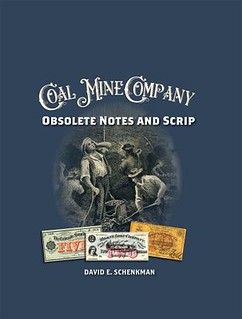 When Coal Mine Company Obsolete Notes and Scrip was published two years ago I listed two denominations of Coaling Supply Company (Coaling, Alabama) notes, but I didn't know about this one until it was listed in a recent Heritage sale.
When Coal Mine Company Obsolete Notes and Scrip was published two years ago I listed two denominations of Coaling Supply Company (Coaling, Alabama) notes, but I didn't know about this one until it was listed in a recent Heritage sale.
The Chariton Coal Company was also unlisted in the book. I listed a different denomination on the basis of a partial description in a book published many years ago, but I had never seen an actual note from the company. Only a few Iowa coal companies are known to have issued notes.
The Pinetucky Gold Mines note is also another recent Heritage purchase. Only five or six mining companies in the South are known to have issued scrip, and only two of them are Civil War. This was part of the John Ford collection, which was sold in 2005.
To read the earlier E-Sylum article, see:
NEW BOOK: COAL MINE OBSOLETE NOTES AND SCRIP (https://www.coinbooks.org/v26/esylum_v26n29a06.html)
Scovill Malleable Nickel
Dave also brought along this great proof token from the Scovill company.
Dave writes:
"This 21mm token was probably given to prospective customers for nickel coins or tokens."
Apollonoshieron Bronze
Robert Hoppensteadt bought this large bronze from Apollonoshieron.
LYDIA. Apollonoshieron. Caracalla (198-217). Flavius Aurelius Eilus, archon.
28.17 gr, 39 mm, 0 h, VF
Obv: AV K M AVP ANTON?INOC.
Laureate and cuirassed bust right.
Rev: ??I F? AV?H ?I?OY N? AP? A / A?O??ONOI???ITON.
Hexastyle temple, containing Apollo standing facing, head left, resting hand upon lyre to right. RPC V.2 81842
Robert writes:
"This is the plate coin and only listed example. One other sold at CNG years ago."
Steve's Beauties
Steve Bishop often brings along some really nice U.S. coins, often "toners." Here are five toned Morgan dollars he brought this month - they were especially nice viewed in person.
Jon's Medals and Such
Jon Radel brought a couple of interesting medals and a book that answers an earlier question.
"I brought a couple of items. The first was the answer to an off-hand question Wayne asked several issues of the E-Sylum back: How does one tell the difference between K. Goetz's original Lusitania medals and the many restrikes, propaganda "copies," etc.? I brought along my copy of Greg Burns' Commemoration of Death: The medals of the Lusitania Murders from 2012. There is, now that I look, an E-Sylum article at https://www.coinbooks.org/esylum_v15n36a02.html from when the book was published.
I also, having a reputation to uphold, brought some solid hunks of bronze from Finland with me. The first was the 1984 (when bronze was much cheaper) Raimo Heino, Raimo Heino, a rather self-indulgent medal the artist issued for his birthday. The obverse legend is "RAIMO HEINO SCULPTOR SUMMÆ GLORIÆ SUÆ IPSE FECIT." Google Translate renders that as "He himself made it to his highest glory." Of course, he's not too serious, that sure looks more like a croquet mallet than a polo mallet he's waving around on the back of a horse. 1582g, 135mm."
Jon adds:
The Guild of Medallic Art in Finland runs an annual competition for a medal they sell to the membership. In 2023 Petri Neuvonen won with his "The Medal in Progress." 480g, 105mm. As purchasers learned:
The artist himself says that the basic idea of the works was to create a medal that would not refer to anything outside of itself. "Often the medal is perceived only as a domain for some outer content, theme or image. Now I wanted to make a medal that doesn't rely on external meanings but would sufficient in itself."
Take that those who don't think it's a medal unless it's commemorating something.
I remarked that I wouldn't be surprised to find a lump of metal that looked like this in the ruins of a house fire, but that to create something like this on purpose was quite the accomplishment. I'm not dissing the medal - I think it's a fine, thought-provoking work.
Eric's Acquisitions
Eric Schena has a great eye for rare local material.
Eric writes:
 "In keeping with my tendency to bring Mid-Atlantic material, I brought a couple of recent Virginia bank note acquisitions that I like to categorize under the heading of "ratty but rare." In addition to a pair of extremely rare obsoletes from the Merchants Bank of Virginia from Lynchburg, I also passed around an earlier Farmers Bank of Virginia $10 from Richmond, and most importantly for me, a very rare early contemporary counterfeit $10 from the Winchester branch of the Farmers Bank of Virginia from 1819. The only other one I have run across is a cut central vignette from a genuine note that was given to me as a gift maybe 20 years ago that came from the 1983 Affleck sale.
"In keeping with my tendency to bring Mid-Atlantic material, I brought a couple of recent Virginia bank note acquisitions that I like to categorize under the heading of "ratty but rare." In addition to a pair of extremely rare obsoletes from the Merchants Bank of Virginia from Lynchburg, I also passed around an earlier Farmers Bank of Virginia $10 from Richmond, and most importantly for me, a very rare early contemporary counterfeit $10 from the Winchester branch of the Farmers Bank of Virginia from 1819. The only other one I have run across is a cut central vignette from a genuine note that was given to me as a gift maybe 20 years ago that came from the 1983 Affleck sale.
"In addition, I also brought a quite nice French colonial 1743-C sou marque (Vlack 60) in a PCGS AU-50 holder that came from a local auction, which is far from the norm of what I usually see around my area. I recently joined the local French and Indian War society and even helped with an archaeological excavation on the site of Fort Loudoun, so the earlier French colonial material holds an interest for me."
JK, Julian and I were the last to leave the restaurant. It was another great night of numismatic fellowship. I had a great time, despite breaking my back bringing so many books along. Yeah, I know I sold my main numismatic library last year. But once a numismatic bibliophile, always a numismatic bibliophile. I just can't help myself - when I see a rare or interesting book I haven't owned before, I'm happy to acquire it.
To read the earlier E-Sylum articles, see:
NEW BOOK: CENTS AND HALF CENTS OF MASSACHUSETTS
(https://www.coinbooks.org/v28/esylum_v28n41a04.html)
NEW BOOK: THE NUMISMATIST'S GUIDE
(https://www.coinbooks.org/v28/esylum_v28n36a03.html)
NEW BOOK: GOLD COINS OF NEW ORLEANS MINT 5TH ED.
(https://www.coinbooks.org/v28/esylum_v28n32a04.html)
NEW BOOKS: U.S. LARGE CENTS, 2ND EDITION
(https://www.coinbooks.org/v28/esylum_v28n41a06.html)
NEW BOOK: BAD METAL: SILVER 3 TO 25 CENTS
(https://www.coinbooks.org/v25/esylum_v25n32a06.html)
NEW BOOK: BAD METAL: SILVER 50C TO $1
(https://www.coinbooks.org/v28/esylum_v28n21a04.html)
SELECTED LOTS FROM KOLBE-FANNING SALE #137 : Lot 8: Bathe, Jacob Perkins
(https://www.coinbooks.org/esylum_v17n43a16.html)
NNP ADDS SAN FRANCISCO MINT NOTEBOOK
(https://www.coinbooks.org/v28/esylum_v28n35a05.html)
NEW BOOK: THE MEDALS OF THE LUSITANIA
(https://www.coinbooks.org/esylum_v15n36a02.html)
SPANISH COIN DISCOVERED ON NANTUCKET
Hobbyist and Metal detector Travis Nichols found a 1782 silver Spanish one-reale on a beach on the south shore of Nantucket. Thanks to Howard Berlin for passing this along. -Garrett
A mysterious 18th-century coin recently resurfaced on a beach in Nantucket, thanks to one determined metal detectorist.
Hobbyist Travis Nichols found the coin — a 1782 silver Spanish one-reale — at a beach on the south shore of the island, according to an Oct. 9 report by the Nantucket Inquirer and Mirror.
Nichols is known in the local community, the publication said, for helping others find jewelry and other metal objects they've lost on Nantucket's beaches.
But his sights were always on historic coinage: He boasts more than 300 coins in his private collection, something he said he cherishes.
Speaking to the Inquirer and Mirror, Nichols said that finding the rare coin was "an amazing feeling."
"Is returning a $25,000 ring super-important and community-focused? Absolutely," Nichols said of helping his neighbors.
"But selfishly, finding a $30 silver coin is the top."
He told the same source he believes that, based on its marks, the coin was minted in Mexico City.
Nichols said the coin is relatively young, as Nantucket detectorists have found coins dating back to the 1650s on the island.
"This coin came from Mexico City, somehow sailed to New England and then probably took another ship to Nantucket," Nichols said. He mused, "What was it doing on the south shore?"
The spot where the coin was found appears to be promising. Nichols previously found a historic penny there — notably, it was clipped to half its value.
"To think on Nantucket, a penny was too much money," the detectorist remarked.
To read the complete article, see:
Treasure hunter's persistence pays off with rare Spanish coin discovery on Nantucket beach
(https://www.foxnews.com/travel/treasure-hunters-persistence-pays-off-rare-spanish-coin-discovery-nantucket-beach)
THE NORMAN WAIT HARRIS PRIZE MEDAL
Numismatic connections are everywhere. A random internet factoid I came across this week stated that $300 was the "Amount American Gothic won (along with a bronze medal) in a 1930 contest at the Art Institute of Chicago." Looking for more information on the medal I learned that Victor David Brenner designed it, and it was struck by the Medallic Art Company. I wasn't familiar with this medal and located a description on the website of New York's Metropolitan Museum of Art. -Editor
 Established in 1902, the Norman Wait Harris Prize was a medal and cash prize awarded to an artist for a painting displayed in the Art Institute of Chicago's annual exhibition of American paintings and sculpture. Both a Silver Medal and a Bronze Medal were presented annually, and in 1936 the Bronze Medal was awarded to leading Ashcan School painter William James Glackens for his painting The Soda Fountain (1935; Pennsylvania Academy of the Fine Arts). The obverse of the medal bears an allegorical representation of the art of painting, a classically garbed figure holding a palette and brushes. She stands in an architectural entranceway with a cloud-filled sky behind her. The reverse depicts the central façade of the Art Institute of Chicago, with oak and laurel branches flanking the central inscription.
Established in 1902, the Norman Wait Harris Prize was a medal and cash prize awarded to an artist for a painting displayed in the Art Institute of Chicago's annual exhibition of American paintings and sculpture. Both a Silver Medal and a Bronze Medal were presented annually, and in 1936 the Bronze Medal was awarded to leading Ashcan School painter William James Glackens for his painting The Soda Fountain (1935; Pennsylvania Academy of the Fine Arts). The obverse of the medal bears an allegorical representation of the art of painting, a classically garbed figure holding a palette and brushes. She stands in an architectural entranceway with a cloud-filled sky behind her. The reverse depicts the central façade of the Art Institute of Chicago, with oak and laurel branches flanking the central inscription.
The above image is an unissued bronze example in the collection of the Art Institute of Chicago. Below is a silver example from MedallicArtCollector.com. -Editor
 MedallicArtCollector.com notes that "The medal's obverse bears a striking resemblance in design to Hermon A. MacNeil's Standing Liberty quarter of 1916. It has been speculated that this medal inspired MacNeil's design."
MedallicArtCollector.com notes that "The medal's obverse bears a striking resemblance in design to Hermon A. MacNeil's Standing Liberty quarter of 1916. It has been speculated that this medal inspired MacNeil's design."
American Gothic is in the collection of the Art Institute of Chicago. So where is the medal awarded to Grant Wood today? Inquiring numismatists want to know. Meanwhile, here's an excerpt from a great article on the famous painting from Christies - see the complete article online. -Editor
 In 1930, an unknown American painter named Grant Wood decided to send one of his pictures to the juried annual open exhibition at the Art Institute of Chicago. Much to his delight, he won a prize, the Norman Wait Harris Bronze Medal, and with it $300 in cash: no mean sum for a struggling artist in his late twenties, born and raised on a remote farm in Iowa, trying to make his way in the provincial wilds of the American Midwest at the outset of the Great Depression.
In 1930, an unknown American painter named Grant Wood decided to send one of his pictures to the juried annual open exhibition at the Art Institute of Chicago. Much to his delight, he won a prize, the Norman Wait Harris Bronze Medal, and with it $300 in cash: no mean sum for a struggling artist in his late twenties, born and raised on a remote farm in Iowa, trying to make his way in the provincial wilds of the American Midwest at the outset of the Great Depression.
Little did he know, but that bronze medal marked the beginning of one of the unlikeliest stories in the history of art. Wood's prizewinning picture, portraying a hard-bitten farming couple and entitled American Gothic, was soon to be championed as the masterpiece of a new American art movement called ‘Regionalism', first invented, and then promoted, by an impresario and art dealer from Kansas named Maynard Walker.
According to Walker, whose words carried influence, such work represented a robust all-American riposte to the ‘shiploads of rubbish that had been imported from the School of Paris' by the effete and gullible art collectors of New York. In American Gothic he saw a picture that dared to present real Americans, in all their true grit, to American eyes.
It is perhaps no exaggeration to say that American Gothic has become the USA's answer to the Mona Lisa: the one picture that every American recognises, without necessarily knowing anything about its maker, his motives, or the mystery that still clings to it.
To read the complete article, see:
American Gothic: Grant Wood's Midwestern mystery
(https://www.christies.com/en/stories/american-gothic-a-midwestern-mystery-37605e6e8e7d4499847f7cf08a09b9fc)
References:
The models for the painting ‘American Gothic' were the artist's sister and dentist.
(https://interestingfacts.com/fact/the-models-for-the-painting-american-gothic-were-the-artists-sister-and-dentist/)
Norman Wait Harris Prize Medal by Victor David Brenner
(https://beta.medallicartcollector.com/glossary/awards/art-institute-chicago)
Norman Wait Harris Prize medal
(https://www.artic.edu/artworks/146351/norman-wait-harris-prize-medal)
Standing Liberty Quarters (1916-1930)
(https://www.ngccoin.com/coin-explorer/united-states/quarters/standing-liberty-quarters-1916-1930/)
HAMILTON AND CHERNOW WIN LIBERTY MEDAL
The National Constitution Center bestowed its annual Liberty Medal on the Broadway musical Hamilton and historian and biographer, Ron Chernow, whose book inspired the musical. The Liberty Medal honors men and women of courage and conviction who strive to secure the blessings of liberty to people around the globe. Here is the press release. -Garrett
The National Constitution Center's annual Liberty Medal honors men and women of courage and conviction who strive to secure the blessings of liberty to people around the globe. On Friday, October 17, 2025, we honored beloved Broadway hit, Hamilton, which marks its 10th anniversary this year, and the acclaimed historian and biographer, Ron Chernow, whose book inspired the musical.
The 2025 Liberty Medal Ceremony
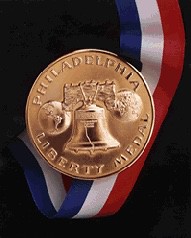 The 37th annual Liberty Medal was awarded on October 17, 2025, to the beloved Broadway hit, Hamilton, which marks its 10th anniversary this year, and the acclaimed historian and biographer, Ron Chernow, whose book inspired the musical. The Liberty Medal ceremony took place at the National Constitution Center in Philadelphia.
The 37th annual Liberty Medal was awarded on October 17, 2025, to the beloved Broadway hit, Hamilton, which marks its 10th anniversary this year, and the acclaimed historian and biographer, Ron Chernow, whose book inspired the musical. The Liberty Medal ceremony took place at the National Constitution Center in Philadelphia.
In addition to a fireside chat between Ron Chernow and NCC President and CEO Jeffrey Rosen, the ceremony included performances from Philadelphia native Ta'Rea Campbell, who played Angelica Schuyler in the national tour of Hamilton for five years, and Heather Leslie Sanchez, a senior at Piscataway Magnet School, the 2024-2025 Hamilton Education Program competition winner.
The Liberty Medal is made possible thanks to support from corporations, foundations, and individuals with proceeds going to further the work of the National Constitution Center. Learn more about sponsorship opportunities.
The 2025 Liberty Medal Recipients
Ron Chernow, a masterful storyteller of American history, brings our nation's past vividly to life through his award-winning biographies of extraordinary figures. His debut, The House of Morgan, received the National Book Award, while Washington: A Life earned the Pulitzer Prize for Biography. His celebrated Alexander Hamilton won the George Washington Book Prize. A two-time finalist for the National Book Critics Circle Award, Chernow is one of only three living biographers to be honored with the Gold Medal for Biography from the American Academy of Arts and Letters. A former president of PEN America, he has also been awarded nine honorary doctorates. His most recent biography of Mark Twain was published in May and debuted as number one on The New York Times bestseller list. The Times of London hailed the book as "a model biography, one of the finest of recent years."
Based on Ron Chernow's acclaimed biography and set to a score that blends hip-hop, jazz, R&B, and Broadway, Hamilton has had a profound impact on culture, politics, and education. In addition to its 11 Tony Awards, it has won Grammy and Olivier Awards, the Pulitzer Prize for Drama, and an unprecedented special citation from the Kennedy Center Honors. Hamilton features a book, music, and lyrics by Lin-Manuel Miranda, direction by Thomas Kail, choreography by Andy Blankenbuehler, and musical supervision and orchestrations by Alex Lacamoire. Hamilton's portion of the Liberty Medal prize will benefit Gilder Lehrman's Hamilton Education Program.
To read the complete article, see:
Liberty Medal
(https://constitutioncenter.org/about/liberty-medal)
For more information (subscription required), see:
Ron Chernow accepts the Liberty Medal for ‘Hamilton,' the first artwork to receive the recognition
(https://www.inquirer.com/arts/theater/hamilton-liberty-medal-ron-chernow-20251018.html)
THE SMITH AND WINCHESTER MACHINE SHOP
John Ferreri submitted this article about the numismatic connections of the Smith and Winchester firm. Thank you! -Editor
John writes:
"I have attached a short essay about an old factory in Windham Center, Connecticut. The town of Windham is home to the city of Willimantic which happens to be my home town. Aside from this information there is more available on the internet for anyone interested.
"Small New England towns along any size river became industrial meccas for the production of Cotton, Wool and Silk Cloth and threads of the same during the Industrial revolution. And paper making evolved from hand made individual sheets to rolls of paper made possible by the Fourdrinier Press.
"I also submitted this to NENA News, and it might be of interest to E-Sylum readers and collectors in southern New England, Connecticut especially."
Smith and Winchester Machine Shop, South Windham, Connecticut.
If this picture looks like the fire ravaged remains of the brick factory on the corner of Babcock Hill and Machine Shop Hill Roads in South Windham to you, you are correct. The old Smith and Winchester plant was set afire a few years ago, vandalism I assume. Privy to only a few, this plant started in 1828 as the Spafford and Phelps machine shop. This building was erected in 1908 and their prime product was a large and involved machine that made paper in rolls like newsprint, etc. It was called a Fourdriner Press, named after the European inventor and the first made in the U.S.
One of their customers was the Crane Paper Company of Dalton, Massachusetts. Crane made the paper for the U.S Government's paper money (it still does) and used this Windham made machine for their rolls of bank note paper which they sold to the U.S. government which in turn used that paper to print the federal bank notes (paper money) starting in 1863. The U.S.A. only issued coins before this date.
During the 1860s there were various types of notes issued. Some, called National Bank Notes came in various denominations and had the local issuing bank's names engraved right in the design. The notes were then shipped to those banks for use first in the local economy. And of course they could be spent anywhere in the U.S. These old notes are now numismatic treasures.
So readers, the machines made at the Smith and Winchester plant were sold to the Crane Company (paper maker) at Dalton, Mass. that in turn made the paper that was shipped to Washington on which U.S. National Bank notes were printed then sent to the local National Banks (First National Bank and Windham National Bank) and some of these in turn, sent to the payroll office at the South Windham plant of Smith and Winchester to be paid out to the workers who started this whole game!
Like coins, U.S. paper money became a historic and collectable item for hobbyist. Issues from a smaller town that needed less of the notes became more expensive due to their rarity compared to others. The bank notes printed for the local banks in this area are in demand for collectors of such stuff! Below, will be shown one of the notes issued in Willimantic. This is how numismatic history was made in South Windham!
FRENCH MUSEUM THEFTS
Justin Perrault passed along this article about the latest in a string of museum thefts in Europe. Thank you. Sad to learn this. It comes hot on the heels of the Louvre theft, this time for coins. -Editor
A small museum in northeastern France reported a theft on its premises on Monday, October 20, one day after the astonishing daytime jewels heist at the Louvre. La Maison des Lumières Denis Diderot, housed in the Hôtel du Breuil-de-St-Germain private mansion in Langres, said that a display had been broken into and several gold and silver coins stolen while the institution was closed on Monday per its usual operating schedule.
According to a press release issued by the Langres municipal police, museum staff arrived on Tuesday morning to find evidence of forced entry as well as shards of the display case that held the coins scattered across the floor. Investigators believe that the burglary was both targeted and planned, and the museum remains closed to the public until further notice.
Devoted to the 18th-century French philosopher, art critic, and writer Denis Diderot, La Maison des Lumières houses a collection of his personal effects and other objects pertaining to his life, work, and writing. Tools like printing hardware and measuring implements are displayed alongside evidence of Diderot's research and his text for the first edition of the Encyclopediè, which he co-edited, as are various portraits and carved busts of the influential Enlightenment-era philosopher.
The precious coins taken by the burglars were part of a trove of nearly 2,000 uncovered in 2011, found within the museum's woodwork during a structural renovation of the mansion. Per French law, half of the assortment was awarded to the person who discovered it, while the remainder entered the custody of the town as the property owner — a portion of which was ultimately displayed in a vitrine at the museum.
To read the complete articles, see:
French Museum Reports Theft One Day After Louvre Heist
(https://hyperallergic.com/1051349/french-museum-reports-theft-one-day-after-louvre-heist/)
Après le casse du Louvre, le musée de Langres, en Haute-Marne, cambriolé
(https://www.lefigaro.fr/culture/patrimoine/apres-le-casse-du-louvre-le-musee-de-langres-en-haute-marne-cambriole-20251021)
Gold and silver coins stolen from French museum hours after Louvre heist
(https://www.washingtonpost.com/world/2025/10/23/france-musem-heist-coins-diderot-louvre/)
There was a development in the Louvre case Sunday morning. Here's an excerpt from the New York Times. -Editor
The police have made arrests in the brazen jewelry heist last week at the Louvre Museum in Paris, French authorities said on Sunday, without saying how many people had been taken into custody.
The robbery was carried out by four people. Laure Beccuau, the Paris prosecutor, said in a statement that the arrests were made on Saturday evening and that one man was arrested at the Roissy-Charles de Gaulle Airport as he was trying to leave the country.
It was not immediately clear whether the police had recovered any of the stolen jewelry, worth more than $100 million, which included gem-studded royal tiaras, necklaces and earrings.
To read the complete article, see:
Police Make Arrests in Louvre Robbery, Authorities Say
(https://www.nytimes.com/2025/10/26/world/europe/louvre-heist-arrests.html)
This NPR article is the source of the above illustration: "Daily Scene in the Louvre, a 1911 cartoon by Samuel Ehrhart, shows patrons blatantly stealing works from the museum after an inventory at the time found that over 300 canvases were missing." -Editor
To read the complete article, see:
This isn't the Louvre's first high-profile heist. Here's a history of earlier thefts (https://www.npr.org/2025/10/20/nx-s1-5580221/louvre-museum-robbery-history)
MRBEAST CASH STUNTS
You've all no doubt heard of 27-year-old Jimmy Donaldson, whose MrBeast YouTube channel has more than 430 million subscribers. Bloomberg BusinessWeek recently published a profile. The videos often involve cash prizes and big piles of coins and bills. Garrett added some of the videos - check 'em out. Thanks. -Editor
The content is similar to that of reality competition shows such as Fear Factor or Survivor, but it's tailored to the short attention spans of the internet. Donaldson begins each video by shouting the premise to hook the viewer and dangling a huge reward or twist, typically a large cash prize, to keep people watching. A recent example: "I just bought this luxurious private jet, and if this pilot can spend 100 days trapped inside, he keeps it!" A clock at headquarters gives a live update of the subscriber count, which grows by the minute. Donaldson's channels across YouTube, Instagram, TikTok and X reach more than 1 billion unique viewers every 90 days, the company says.
So far he's leveraged his fame to sell chocolate bars, snack kits and digital tools to help other content creators go viral; in the next few years, he plans to build an animation studio, create a video game platform and write a thriller with author James Patterson. (The novel, which prompted a bidding war among publishers, will center on "an extreme global contest," according to the New York Times.)
Donaldson is operating at a greater scale than his peers. Beast Industries employs about 450 people, more than 300 of whom make videos. Another 100 work on the chocolate business, Feastables, and dozens work on the snack company, Lunchly LLC, and the software company, Viewstats. Beast generated about $450 million in sales last year, evenly split between the video operation and Feastables. Yes, Donaldson pulls in more than $200 million a year in dark chocolate sea salt bars and peanut butter cups, a business projected to double in size in the next few years, according to pitch documents sent to investors. Feastables vending machines are scattered around the offices, and posters remind employees to incorporate product placements in videos. "We are able to generate the demand," he says.
Right now, however, Beast Industries is hemorrhaging money. It's had three years of losses, including more than $110 million in 2024. The viral videos account for all of it, overwhelming the profits from Feastables. Donaldson has been spending between $3 million and $4 million on every video he produces for the main YouTube channel, most of which lose money.
The chronic loss of money notwithstanding, much of the MrBeast strategy boils down to "Less is more." Rather than produce 100 videos and hope one hits, he makes one video that he expects will get as many views as possible. In 2018 he decided to buy a $12,000 car for his stepdad—with coins. He intended to withdraw 1.2 million pennies from the bank, but after realizing there might not be that many pennies in all of North Carolina, he included nickels, dimes and quarters, which he and his friends hauled to a local dealership in wheelbarrows. Donaldson grabs the viewer by injecting doubt about the mission: Surely, the dealership wouldn't accept $12,000 in coins, right? But it did, and Donaldson settled on a 2014 Jeep Patriot with 98,000 miles. If a video works—this one got 26 million views, which was a lot seven years ago—Donaldson re-creates it with a twist, such as buying a $17,500 Chevy Camaro with $1 bills.
In one, he tipped pizza delivery guys hundreds of dollars when they dropped off pies, ultimately giving out about $10,000. He repeated the stunt with Uber drivers. In another video, he took $30,000 from a sponsor and gave it to a random Twitch streamer. He gave 3 million pennies to his 3 millionth subscriber.
In a conference room on the second floor of Beast Industries, Shrek plays on a TV in the background. A security guard sits along the wall, watching a dozen young adults around a table flatten out $1 bills. Donaldson gives away such large sums of money in his videos that he withdraws millions of dollars in singles from the bank. His team then crumples the bills to create a mountain that looks more impressive on camera than would a neatly stacked pile. The crumpling is so time-consuming that an employee eventually created a machine to automate the process. "I never thought when I went to Harvard Business School I would have to figure out how to crumple money," says Housenbold, standing next to a black tub filled with bills that look more crumpled than not. (Beast doesn't use the singles to pay rewards—it wires money to winners—so employees flatten and reband the bills to return to the bank.)
Donaldson has learned, though, that he doesn't always need to spend more money to drive viewership. There isn't a huge difference between giving away $1 million and $100,000; an average viewer sees both numbers as big and will tune in for the results. In fact, giving away $1 million sometimes suppresses viewership. "We definitely found the point where more money doesn't equal more views," Donaldson says. "If I were to give a random person on the street a million dollars, a lot of people who see that video, especially because we have a very international audience—they just don't think it's real."
To read the complete article, see:
MrBeast on His Quest to Turn YouTube Fame Into an Entertainment Empire
(https://www.bloomberg.com/news/features/2025-09-22/youtube-star-mrbeast-is-building-an-entertainment-empire/)
LOOSE CHANGE: OCTOBER 26, 2025
Here are some additional items in the media this week that may be of interest. -Editor
CoinWeek has an article on the current "Liquidity Crisis for Junk Silver." Here's an excerpt - see the complete article online. -Editor
 The market for junk silver, primarily pre-1965 U.S. 90% silver coinage, is currently experiencing an unprecedented liquidity crisis. This disruption is stemming from severe refining backlogs and an associated spike in the cost of financing silver, which has effectively frozen the process by which scrap and less-than-.999-fine silver is converted into investment-grade bullion. The result is a growing disconnect between the spot price of silver and the real-world ease of buying or selling physical metal, placing a strain on both retail and wholesale market participants.
The market for junk silver, primarily pre-1965 U.S. 90% silver coinage, is currently experiencing an unprecedented liquidity crisis. This disruption is stemming from severe refining backlogs and an associated spike in the cost of financing silver, which has effectively frozen the process by which scrap and less-than-.999-fine silver is converted into investment-grade bullion. The result is a growing disconnect between the spot price of silver and the real-world ease of buying or selling physical metal, placing a strain on both retail and wholesale market participants.
Refiners have been inundated with material, partly due to Americans liquidating silver assets in response to high prices. However, the true breaking point has been a massive surge in silver lease rates—the interest rate paid to borrow physical silver. In normal times, refiners borrow silver or cash at low rates to finance the metal while it is being processed. Recently, these lease rates have skyrocketed from typical single-digit percentages to levels nearing 100% or more. This makes it uneconomical for refiners to accept and hold new material, as the financing costs wipe out any potential profit.
To read the complete article, see:
The Silver Freeze: Refining Backlogs Create a Liquidity Crisis for Junk Silver
(https://coinweek.com/the-silver-freeze-refining-backlogs-create-a-liquidity-crisis-for-junk-silver/)
Kavan Ratnatunga passed along this study of coins and banknotes circulating around the world. Thanks. -Editor
From the US phasing out the penny to Germany's push for cash payment rounding, the relationship between coins and banknotes is transforming—but coins are far from obsolete. While banknotes grow as a store of value, coins continue to play a vital role in everyday transactions, supported by smart denominational strategies and durable innovations. Explore how central banks are adapting currency structures, balancing tradition with efficiency, and ensuring coins remain essential in the diverse ecosystem of cash.
This article addresses recent statistical trends of both payment instruments from various angles. It will start with some general statistics about coins vs. notes. Thereafter, it will focus on the note/coin boundary and trends in the issuance of new coin vs. note denominations. It will conclude with a study of the replacement of low-end paper notes on the one hand with high-value coins and the other with more durable note substrates.
To read the complete article, see:
Global Developments in Coins v Banknotes
(https://cashessentials.org/global-developments-in-coins-v-banknotes/)
For bibliophiles, here's a story about an inmate who built 500 prison libraries. -Editor
 Reginald Dwayne Betts carjacked a man who was asleep in his car in a parking lot in Fairfax County, Virginia. Betts, who was 16 at the time, was tried as an adult and spent nearly a decade in state prison, much of that time in solitary confinement.
Reginald Dwayne Betts carjacked a man who was asleep in his car in a parking lot in Fairfax County, Virginia. Betts, who was 16 at the time, was tried as an adult and spent nearly a decade in state prison, much of that time in solitary confinement.
Books weren't allowed in "the hole." But the men in the prison devised a pulley system using torn sheets and pillowcases to pass books from the general population to people in solitary.
Betts started writing every day and reading anything he could get his hands on. Books transformed him, he says, revealing that other ways of living were possible.
When Betts got out, he earned his bachelor's degree, then a law degree from Yale Law School. He became a poet and an advocate for prison reform, as well as a MacArthur "genius grant" recipient for his work with his nonprofit Freedom Reads, which installs libraries in prisons across the country.
To read the complete article, see:
A smuggled book changed his life. Now he's built 500 prison libraries.
(https://www.washingtonpost.com/lifestyle/2025/10/24/smuggled-book-changed-his-life-now-hes-built-500-prison-libraries/)
ABOUT THIS ISSUE: OCTOBER 26, 2025
This week's been blur, and I'm not sure where the time went, although you can read all about Tuesday night in my diary article elsewhere in this issue. I was in the office Monday and Thursday, and got caught up on various chores the other days. My desk and office are a bit more organized. I got a head start on The E-Sylum, yet I was still pulling the issue together on Sunday evening and as always, there was a lot of potential material left on the cutting room floor.
Here's a comic suitable for Halloween season. Some nights I fear this may be how I meet my end someday.
Finally, here are some interesting non-numismatic articles I came across this week.
The Mystery of the Ancient Roman Gravestone Discovered in a Family's Backyard Has Been Solved
(https://www.smithsonianmag.com/smart-news/the-mystery-of-the-ancient-roman-gravestone-discovered-in-a-familys-backyard-has-been-solved-180987515/)
Before ‘Hamilton,' the Schuyler Sisters Were Already Stars
(https://www.nytimes.com/2025/10/22/books/review/amanda-vaill-pride-and-pleasure.html)
https://www.designboom.com/technology/power-lines-animal-sculptures-supply-electricity-austria-giants-10-23-2025/
(https://www.designboom.com/technology/power-lines-animal-sculptures-supply-electricity-austria-giants-10-23-2025/)
Is information a fundamental force of the Universe?
(https://aeon.co/videos/a-radical-reimagining-of-physics-puts-information-at-its-centre)
-Editor
Wayne Homren
Wayne Homren is the founding editor of The E-Sylum and a consultant for the Newman Numismatic Portal. His collecting interests at various times included U.S. Encased Postage Stamps, merchant counterstamps, Pittsburgh Obsolete paper money, Civil War tokens and scrip, Carnegie Hero Medals, charge coins and numismatic literature. He also collects and has given presentations on the work of Money Artist J.S.G. Boggs. In the non-numismatic world he's worked in artificial intelligence, data science, and as a Program Manager for the U.S. Department of Defense.
Garrett Ziss
Garrett Ziss is a numismatic collector and researcher, with a focus on American paper money and early U.S. silver and copper coins. He is also a part-time U.S. coin cataloger for Heritage Auctions. Garrett assists Editor Wayne Homren by editing and formatting a selection of articles and images each week. When he's not engaged in numismatics, Garrett is pursuing a Master's Degree in Quantitative Economics at the University of Pittsburgh.
Pete Smith
Numismatic researcher and author Pete Smith of Minnesota has written about early American coppers, Vermont coinage, numismatic literature, tokens and medals, the history of the U.S. Mint and much more. Author of American Numismatic Biographies, he contributes original articles to The E-Sylum often highlighting interesting figures in American numismatic history.
Greg Bennick
Greg Bennick (www.gregbennick.com) is a keynote speaker and long time coin collector with a focus on major mint error coins and US counterstamps. He is on the board of both CONECA and TAMS and enjoys having in-depth conversations with prominent numismatists from all areas of the hobby. Have ideas for other interviewees? Contact him anytime on the web or via instagram
@minterrors.
John Nebel
Numismatist, photographer, and ANS Board member and Fellow John Nebel of Boulder, CO helped the ANA and other clubs like NBS get online in the early days of the internet, hosting websites gratis through his Computer Systems Design Co. To this day he hosts some 50 ANA member club sites along with our
coinbooks.org site, making the club and our E-Sylum archive available to collectors and researchers worldwide.
Bruce Perdue
Encased coinage collector (encasedcoins.info) Bruce Perdue of Aurora, Illinois has been the volunteer NBS webmaster from its early days and works each week to add the latest E-Sylum issue to our archive and send out the email announcement.

